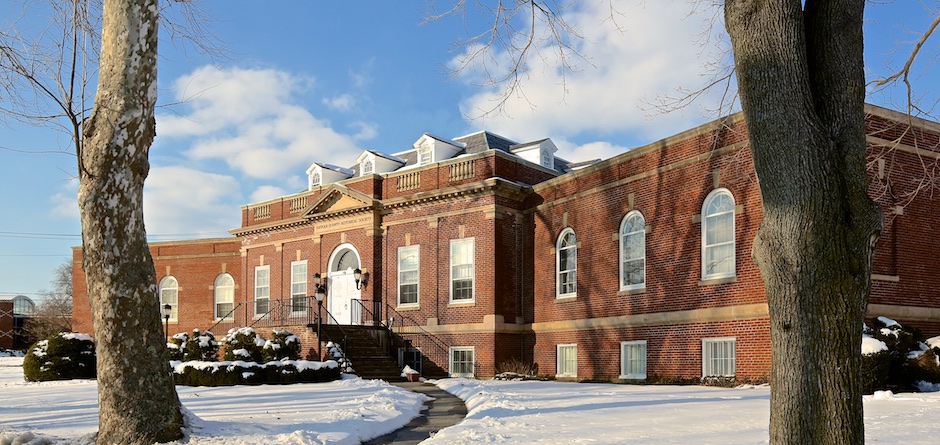SUFFOLK COUNTY HISTORICAL SOCIETY
~~~~~~~~~~~~~~~~~~~~~~~~~~~~~~~~~~~~~
MEMBERSHIP DRIVE
If you’ve been enjoying our Photo of the Week, please consider becoming a member of SCHS. The Suffolk County Historical Society, founded in 1886, collects and preserves the rich history of Suffolk County and beyond. We offer a history museum, art galleries, a research library and archives, and a multitude of exhibits, programs, and educational lectures and workshops year-round. Our unique collections reflect more than three centuries of Long Island history.
Click here to learn about Member Benefits!
—————————-
From the Civil War to civil rights, revolutions to restorations, spies to Suffragettes, boatbuilders to bootleggers, and whalers to wineries, Long Island’s history comes alive at the Suffolk County Historical Society!
Interested in seeing more historical photos from the Collection of the Suffolk County Historical Society? Spend an afternoon at our Local History Library perusing our extensive archival photography collections. We’re open Weds. – Sat., 12:30 – 4:30 PM.
—————————————————–
PHOTO OF THE WEEK SERIES
The Suffolk County Historical Society’s PHOTO OF THE WEEK Series is created by head research librarian Wendy Polhemus-Annibell using historic primary source materials from our local history library’s extensive archives. To subscribe, visit our website or send an email request to Wendy at librarian@schs-museum.org
To view our Photo of the Week archives, visit our website at www.
~~~~~~~~~~~~~~~~~~~~~~~~~~~~~~~~~~~~~~~~
PHOTO OF THE WEEK: December 22, 2019 — FROM THE SCHS LIBRARY ARCHIVES
“How shall we know it is us without our past?”
– John Steinbeck
JOYOUS HOLIDAY SEASON AND HAPPY NEW YEAR
by Wendy Polhemus-Annibell, Head Librarian
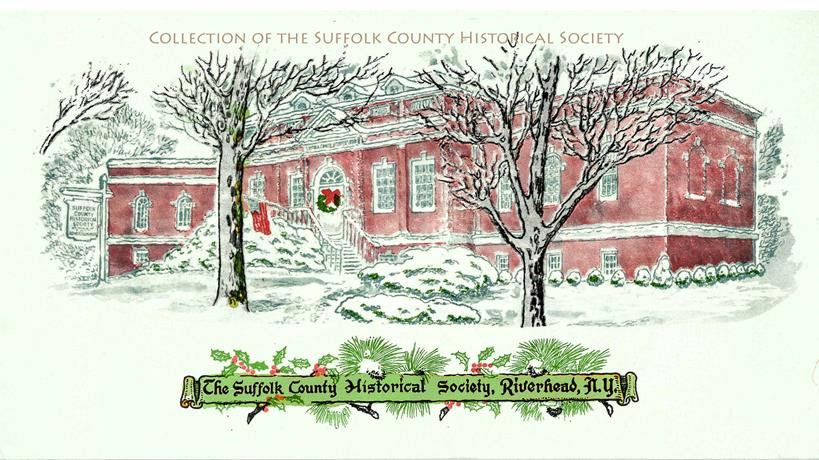
The Staff and Board of the
Suffolk County Historical Society
send warm wishes to all of our
friends and supporters
for a joyous holiday season
and a very happy new year!
******************************************
Visit: www.suffolkcountyhistoricalsociety.org
To View 2014 Photo of the Week pages click here.
To View 2015 Photo of the Week pages click here.
To View 2016 Photo of the Week pages click here.
To View 2017 Photo of the Week pages click here.
To View 2018 Photo of the Week pages click here.
~~~~~~~~~~~~~~~~~~~~~~~~~~~~~~~~~~~~~~~~
PHOTO OF THE WEEK: December 14, 2019 — FROM THE SCHS LIBRARY ARCHIVES
“How shall we know it is us without our past?”
– John Steinbeck
CENTRAL SUFFOLK HOSPITAL
by Wendy Polhemus-Annibell, Head Librarian
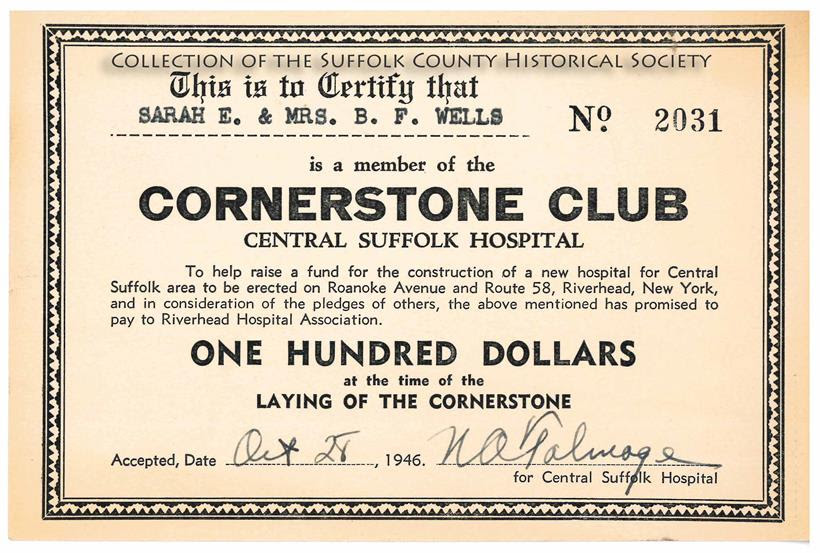
Central Suffolk Hospital Cornerstone Club, Riverhead, 1946.(Image from the Collection of the Suffolk County HistoricalSociety Library Archives. Copyright © Suffolk County HistoricalSociety. All rights reserved.)
“To help raise a fund for the construction of a new hospital for [the] Central Suffolk area to be erected on Roanoke Avenue and Route 58, Riverhead, New York, and in consideration of the pledges of others, the above-mentioned has promised to pay to Riverhead Hospital Association, One Hundred Dollars at the time of the Laying of the Cornerstone.”
Seventy years ago, in December 1949, officers of the Riverhead Hospital Association laid the cornerstone for the hospital that would be built at the northeast corner of Roanoke Avenue and Route 58. The rite of laying a cornerstone is an important cultural component of American architecture.
More than five hundred people braved the threatening weather to attend the cornerstone ceremony. Suffolk County Archdeacon and rector of Grace Episcopal Church Charles W. MacLean spoke about the five years of work and planning that made the construction of a modern “house of healing” possible for Riverhead. Henry R. Talmage, president of the Riverhead Hospital Association, laid the cornerstone and was assisted by Walter Stark and Joseph Celic, also officials of the association. The Riverhead High School band performed a rendition of the national anthem, Rabbi Simon Resnikoff of Temple Israel delivered the invocation, and the Baptist Church Choir performed. Guests included state and federal officials associated with the project.
Several items were enclosed in the cornerstone: The seal of the Riverhead Hospital Association, a ceremony invitation, a copy of the by-laws of the association, the authorization of the state to incorporate and build the hospital, the certificate of incorporation, a Gideon Bible, microfilmed copies of the then-current issues of the Riverhead News and County Review, and a list of the original directors of the hospital.
Construction was completed in 1951 and Central Suffolk Hospital opened its doors in February of that year.
******************************************
Visit: www.suffolkcountyhistoricalsociety.org
To View 2014 Photo of the Week pages click here.
To View 2015 Photo of the Week pages click here.
To View 2016 Photo of the Week pages click here.
To View 2017 Photo of the Week pages click here.
To View 2018 Photo of the Week pages click here.
~~~~~~~~~~~~~~~~~~~~~~~~~~~~~~~~~~~~~~~~
PHOTO OF THE WEEK: December 6, 2019 — FROM THE SCHS LIBRARY ARCHIVES
“How shall we know it is us without our past?”
– John Steinbeck
STONY BROOK BASEBALL
by Wendy Polhemus-Annibell, Head Librarian

Stony Brook Baseball Team (undated). (Image from the Brookhaven Pictorial Collection of the Suffolk County HistoricalSociety. Copyright © Suffolk County Historical Society. All rights reserved.)
Identified on the back of the postcard are these eight players (left to right): Stanley Jewall, Fred Darling, Ernest Bennett, Frank Jacinsky, Duane Squire, Chas Conklin, Leroy Norton, Chester Wood.
Baseball’s popularity as a national pastime spread across Long Island in the years following the Civil War, when it was a game played primarily at county fairs and in farmers’ fields. One of the earliest games recorded in Suffolk County was played at the Suffolk County Fair in Greenport in 1867, when the well-known Huntington Suffolks won the prized Silver Ball. Another well-known team in Suffolk, the Hawkins Nine from Ronkonkoma, played from the 1890s to 1935 and included six Hawkins brothers: Samuel, Morris, E. Stansbury, Ernest, Charles, and Richard.
Leo Fishel (1877-1960) of Babylon played for a number of SuffolkCounty teams. He was one of the first players in the county to make it to Major League Baseball and was the first Jewish pitcher in the majors. In 1899, when Fishel was attending Columbia University, the New York Giants requested him to pitch against the Cleveland Indians. Although Fishel lost his only major league game, he did strike out six batters and even got a hit for his team.
Some other early Suffolk County baseball teams included the Oregons from Mattituck, the Babylon Seniors, the Project Nines from Bay Shore, the St. James Nines, the Riverhead Nines, and the Old Field Club, among others.
Suggested Reading: “Suffolk County Base Ball,” by Robert L. Harrison, SCHS Register, Vol. XXVII, No. 3.
******************************************
Visit: www.suffolkcountyhistoricalsociety.org
To View 2014 Photo of the Week pages click here.
To View 2015 Photo of the Week pages click here.
To View 2016 Photo of the Week pages click here.
To View 2017 Photo of the Week pages click here.
To View 2018 Photo of the Week pages click here.
~~~~~~~~~~~~~~~~~~~~~~~~~~~~~~~~~~~~~~~~
PHOTO OF THE WEEK: November 28, 2019 — FROM THE SCHS LIBRARY ARCHIVES
“How shall we know it is us without our past?”
– John Steinbeck
THANKSGIVING POSTCARD, 1902
by Wendy Polhemus-Annibell, Head Librarian
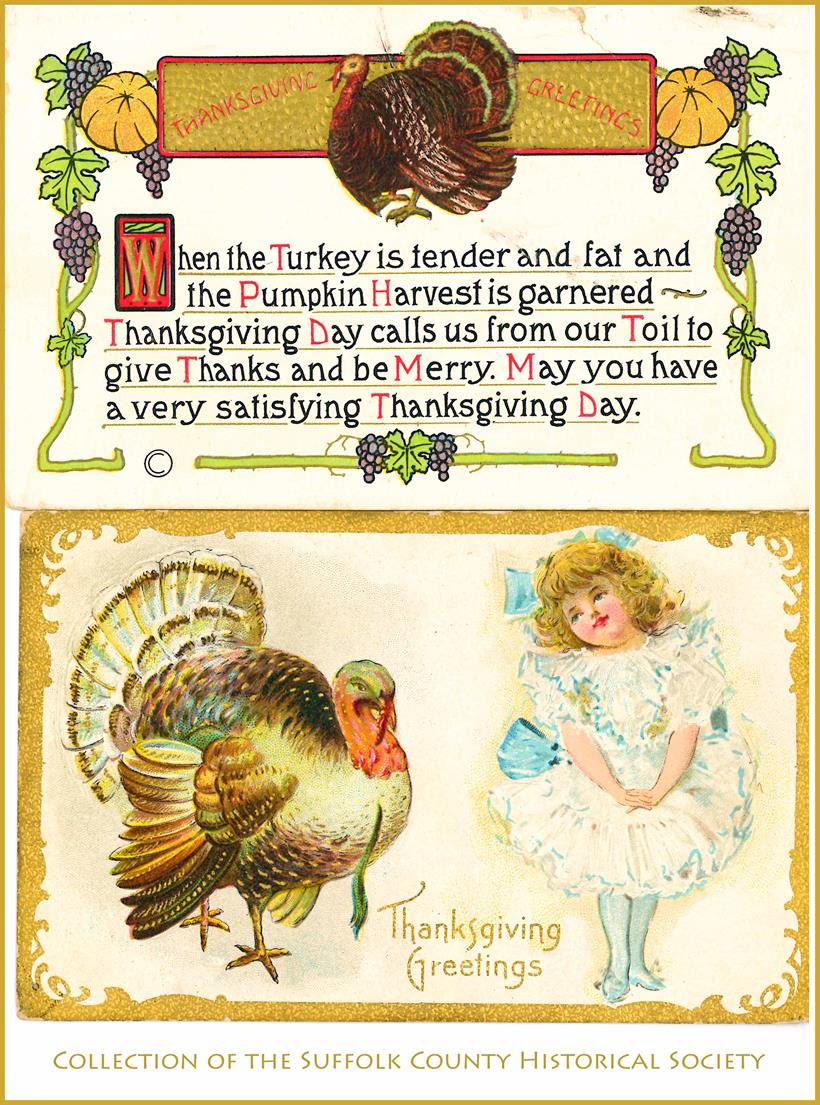
Thanksgiving Postcards, c. 1902. (From the Collection of the SuffolkCounty Historical Society Library Archives. Image © Suffolk CountyHistorical Society. All rights reserved.)
******************************************
Visit: www.suffolkcountyhistoricalsociety.org
To View 2014 Photo of the Week pages click here.
To View 2015 Photo of the Week pages click here.
To View 2016 Photo of the Week pages click here.
To View 2017 Photo of the Week pages click here.
To View 2018 Photo of the Week pages click here.
~~~~~~~~~~~~~~~~~~~~~~~~~~~~~~~~~~~~~~~~
PHOTO OF THE WEEK: November 23, 2019 — FROM THE SCHS LIBRARY ARCHIVES
“How shall we know it is us without our past?”
– John Steinbeck
NORTH SEA
by Wendy Polhemus-Annibell, Head Librarian
North Sea, Sailboat and Cedars in Foreground, 1900, by Hal B. Fullerton. (From the Harry T. Tuthill Fullerton Collection of the Suffolk County Historical Society Library Archives. Image ©Suffolk County Historical Society. All rights reserved.) [To view Fullerton photograph, please visit SCHS website.]
North Sea, a small hamlet located between Southampton and Noyack along the shore of Little Peconic Bay, is where the first English colony arrived in New York State in 1640. Initially referred to as “Northampton,” the area’s name changed to North Sea because the English colonists referred to Peconic Bay as “North Sea” (and to the Atlantic Ocean to the south as “South Sea”). English settlers from Lynn, Mass., sailed into Peconic Bay and anchored near North Sea Harbor. The colonists made their way through the forest, along an Indian path they later named North Sea Path (today North Sea Road), to settle at what became the “Old Town” of Southampton, about three-quarters of a mile from the present village.
******************************************
Visit: www.suffolkcountyhistoricalsociety.org
To View 2014 Photo of the Week pages click here.
To View 2015 Photo of the Week pages click here.
To View 2016 Photo of the Week pages click here.
To View 2017 Photo of the Week pages click here.
To View 2018 Photo of the Week pages click here.
~~~~~~~~~~~~~~~~~~~~~~~~~~~~~~~~~~~~~~~~
PHOTO OF THE WEEK: November 16, 2019 — FROM THE SCHS LIBRARY ARCHIVES
“How shall we know it is us without our past?”
– John Steinbeck
Selah Strong of Setauket
by Wendy Polhemus-Annibell, Head Librarian
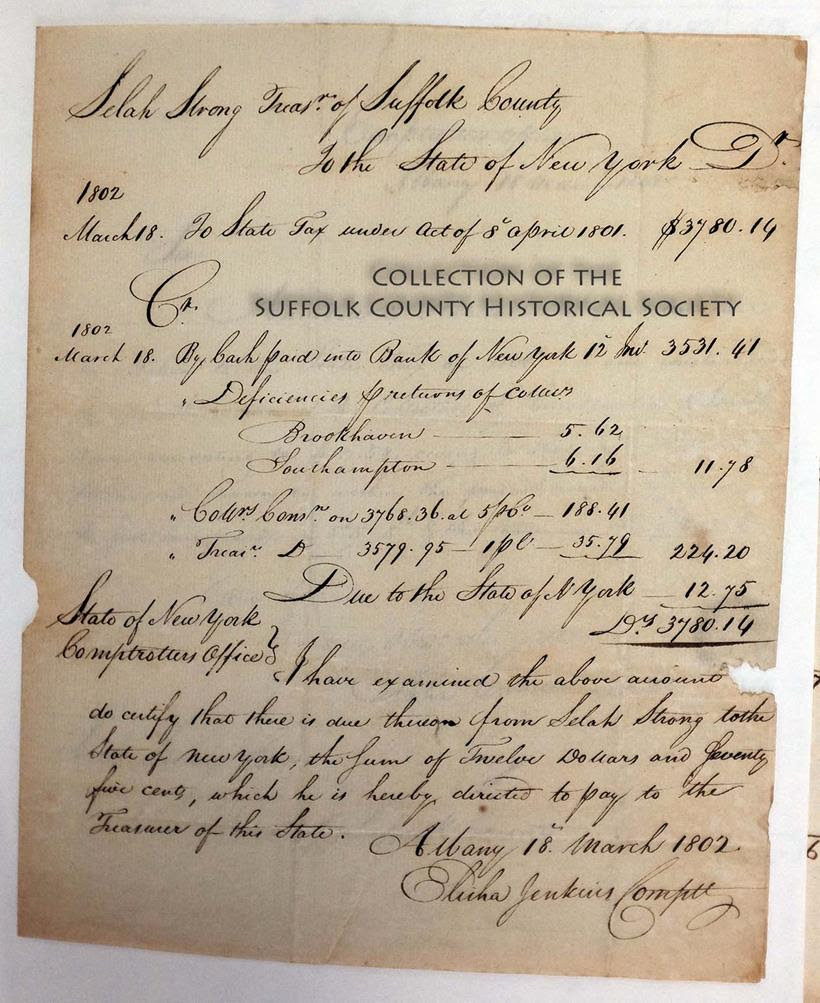
Selah Strong, Treasurer of Suffolk County, to the State of New York, 1802 (State Tax Under Act of 8 April 1801). (From the Selah Strong Papers Collection of the Suffolk County Historical Society Library Archives. Image © Suffolk County Historical Society. All rights reserved.)
Suffolk County Treasurer Selah Strong was born in Setauket in 1737. Strong owned a tavern in Setauket and was a revolutionary war patriot. During the American Revolution, he became a captain in Col. Josiah Smith’s regiment and was at the Battle of Long Island in Brooklyn. After getting into a scuffle with a British army officer, Strong was sent to the prison ship Jersey in Brooklyn Harbor. Anna Strong, Selah’s wife, secured his release through her connections with Culper Spies and the Tories.
Selah Strong of Setauket served in the first three Provincial Congresses, and was a New York State Senator (1792-1800). He held several other posts, among them: Suffolk County Treasurer, Suffolk County Judge, and President of the Brookhaven Board of Trustees. Strong died on July 4, 1815, and is buried in Strong’s Neck, Setauket.
******************************************
Visit: www.suffolkcountyhistoricalsociety.org
To View 2014 Photo of the Week pages click here.
To View 2015 Photo of the Week pages click here.
To View 2016 Photo of the Week pages click here.
To View 2017 Photo of the Week pages click here.
To View 2018 Photo of the Week pages click here.
~~~~~~~~~~~~~~~~~~~~~~~~~~~~~~~~~~~~~~~~
PHOTO OF THE WEEK: November 9, 2019 — FROM THE SCHS LIBRARY ARCHIVES
“How shall we know it is us without our past?”
– John Steinbeck
FDR’S Letter to Mrs. H.B. Fullerton, 1918
by Wendy Polhemus-Annibell, Head Librarian

FDR’s Letter to Mrs. H. B. Fullerton of Medford, April 19, 1918. (From the Collection of the Suffolk County Historical Society Library Archives. Image © Suffolk County Historical Society. All rights reserved.)
During World War I, Hal and Edith Fullerton worked the Medford LIRR Experimental Farm while also contributing to the war effort. Together or individually, they visited troops at Camp Upton, managed a Grub Scouts troop and War Garden, and canned and preserved food from the farm as part of the Long Island Food Reserve Battalion. They also donated items to the U.S. Navy, and in 1918, the Assistant Secretary to the Navy, Franklin D. Roosevelt, wrote to Edith Fullerton to express the Navy’s thanks:
Your prompt and patriotic response to the Navy’s call for binoculars, telescopes, and spy-glasses, is most appreciated. The glasses will be very useful in the prosecution of Naval Operations until victory is won.
At the termination of the war, if possible, every effort will be made to return them to you, when it is hoped that you will feel compensated for any evidence of wear, by the knowledge that you have supplied “Eyes for the Navy” during a very trying period.
On behalf of the Navy, I wish to thank you most heartily.
The letter is signed “Very respectfully” by F. D. Roosevelt, who would become the 32nd U.S. president from 1933 to 1945. According to Eleanor Fullerton, Hal and Edith’s daughter, the binoculars were actually returned to the Fullertons in working condition with “U.S. Navy” stamped on them.
The staff and board of the Suffolk County Historical Society wishes all of our members, our friends, and all veterans a Happy Veterans Day.
—————————————

November 13 – 16, 2019 – Veterans Day Week – Opening of Long Island in Conflict, a Newly Interpreted Permanent Exhibit. Free museum admission for Veterans of all wars during Veterans Day Week, November 13-16!
This newly renovated and permanent exhibit, Long Island in Conflict, offers examples of uniforms, weapons, medals, and other objects from our permanent collection, honoring Long Island’s contribution to our country’s defense. From the earliest days of settlement, Long Islanders have played an active role in the nation’s military history—on battlefields, in theaters of operation, and in conflicts wherever American armies have fought, including on Long Island itself during the American Revolution. On the home front, residents raised money, food, and supplies, and they provided the links to home and family so crucial to a soldier’s performance. The Civil War and the two World Wars saw the largest numbers of Long Islanders in uniform. During the twentieth century, Long Island was the site of major military training grounds, encampments, and airfields. Local industries turned out boats, ships, and torpedoes, and from the 1930s to the 1990s, many of the nation’s military aircraft were built right here on Long Island. Free museum admission for veterans on Nov. 13-16. More info.: 631-727-2881 x100.
******************************************
Visit: www.suffolkcountyhistoricalsociety.org
To View 2014 Photo of the Week pages click here.
To View 2015 Photo of the Week pages click here.
To View 2016 Photo of the Week pages click here.
To View 2017 Photo of the Week pages click here.
To View 2018 Photo of the Week pages click here.
~~~~~~~~~~~~~~~~~~~~~~~~~~~~~~~~~~~~~~~~
PHOTO OF THE WEEK: October 19, 2019 — FROM THE SCHS LIBRARY ARCHIVES
“How shall we know it is us without our past?”
– John Steinbeck
Long Island Agronomist
by Wendy Polhemus-Annibell, Head Librarian
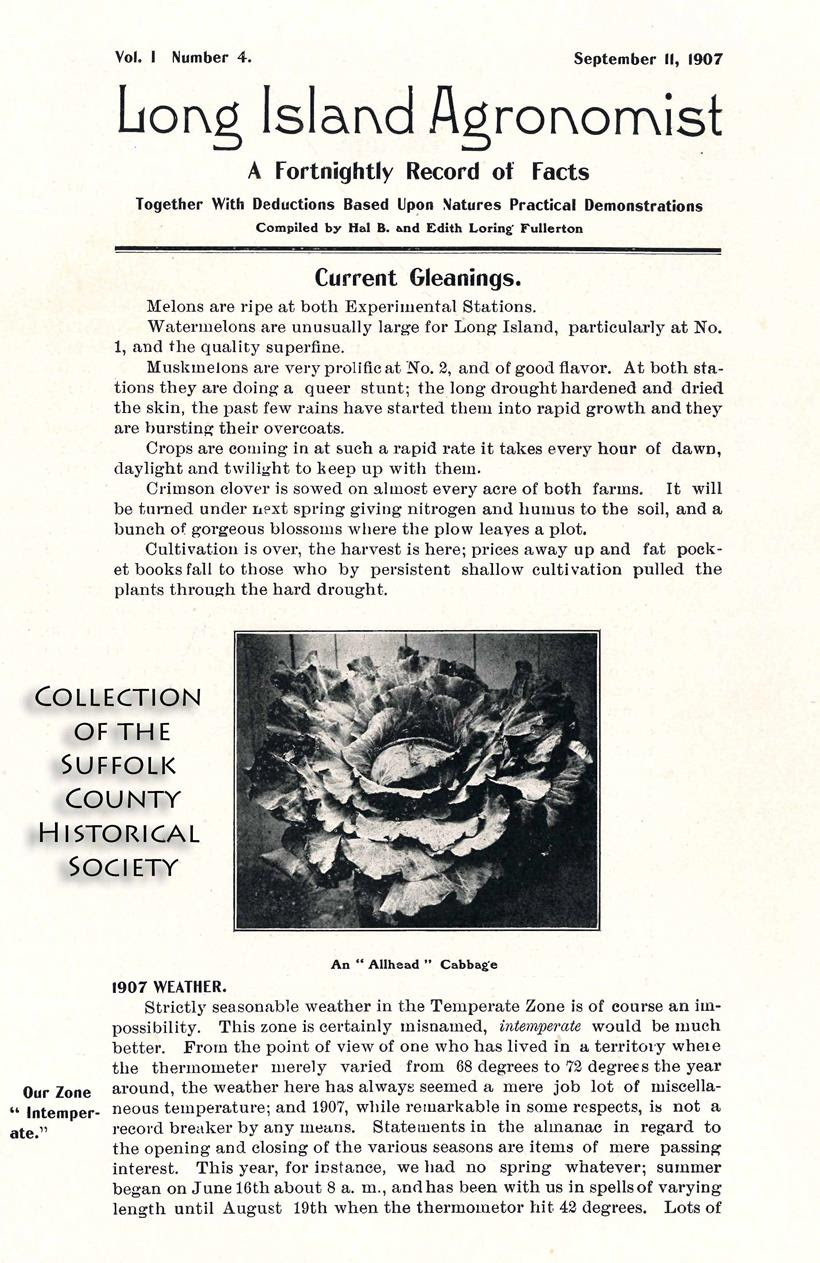
Long Island Agronomist, Sept. 1907. (Image from the Collection of the Suffolk County Historical Society Library Archives.)
Long Island Agronomist was created to promote agriculture on Long Island and to increase the amount of shipping on the Long Island Railroad. The first issue appeared on July 31, 1907. Funded by the LIRR, Hal and Edith Fullerton wrote and published the pamphlet, and Hal shot most of the photographs. TheAgronomist reported on the successes of the LIRR experimental farms and included tips for farmers as well as articles on crops, insects, the weather, agricultural fair announcements, and classified ads. Letters to the editor were sometimes printed as well.
Published every two weeks until December 1910, the Agronomistthen became a monthly publication. Its circulation rose from 600 to 16,000, with farmers from across the United States purchasing subscriptions. In an attempt to cut costs, however, the LIRR’s Department of Agriculture closed the experimental farms and ceased publication of the Long Island Agronomist after the final, November 1914 issue was released.
******************************************
Visit: www.suffolkcountyhistoricalsociety.org
To View 2014 Photo of the Week pages click here.
To View 2015 Photo of the Week pages click here.
To View 2016 Photo of the Week pages click here.
To View 2017 Photo of the Week pages click here.
To View 2018 Photo of the Week pages click here.
~~~~~~~~~~~~~~~~~~~~~~~~~~~~~~~~~~~~~~~~
PHOTO OF THE WEEK: October 12, 2019 — FROM THE SCHS LIBRARY ARCHIVES
“How shall we know it is us without our past?”
– John Steinbeck
Gardiner’s Island
by Wendy Polhemus-Annibell, Head Librarian

Gardiner’s Island (Chace Map, 1858). (Image from the Collection of the Suffolk County Historical Society Library Archives.)
Gardiner’s Island is rich with history that dates back to the colonial days of America. It all started in 1639, when the island was settled by Lion Gardiner. According to Robert David Lion Gardiner in the film Gardiner’s Island: A Visit with Robert David Lion Gardiner (1979), Lion Gardiner acquired the property first by deed from the Montaukett Indians for “a large black dog, some powder and shot, and a few Dutch blankets,” and then by a grant from King Charles I. The island has been privately owned for over three hundred years by Lion Gardiner’s descendants, and is the only property in the United States still intact as part of an original royal grant, Mr. Gardiner tells us in the film.
******************************************
Visit: www.suffolkcountyhistoricalsociety.org
To View 2014 Photo of the Week pages click here.
To View 2015 Photo of the Week pages click here.
To View 2016 Photo of the Week pages click here.
To View 2017 Photo of the Week pages click here.
To View 2018 Photo of the Week pages click here.
~~~~~~~~~~~~~~~~~~~~~~~~~~~~~~~~~~~~~~~~
PHOTO OF THE WEEK: October 5, 2019 — FROM THE SCHS LIBRARY ARCHIVES
“How shall we know it is us without our past?”
– John Steinbeck
Miamogue Hotel, South Jamesport
by Wendy Polhemus-Annibell, Head Librarian

Miamogue Hotel, South Jamesport. (From the Henry W. Prince Collection of the Suffolk County Historical Society Library Archives. Image copyright © Suffolk County Historical Society. All rights reserved.)
Given its pleasant climate, good swimming, and excellent fishing, South Jamesport became a popular late nineteenth-century summer resort area with hotels, parties, dances, moonlit sailing, and the like. This was especially true after the railroad made it possible for people from the city to reach the area relatively easily. Vacationers who arrived by train were met at the station by stages that carried the visitors to one of the hotels that had sprung up near Peconic Bay. The first hotel in South Jamesport was James Tuthill’s Inn, which stood on First Street between Main and Center streets. It burned to the ground, as did the Miamogue Hotel in the same spot. Another Miamogue was constructed here; it also caught fire and was torn down.
The Miamogue Hotel was one of the most well-known resorts in South Jamesport. According to Frederic C. Prince, whose Southold family had a summer home at the hotel, I. Seymour and Josephine (Reeve) Corwin owned and ran the hotel. They raised Josephine’s nieces, Theresa and Florence Reeve, after their mother died. In 1900, Florence Reeve married Fred G. Prince, son of Henry W. Prince. After her marriage, Florence, with her two sons living at the hotel, continued to help run the hotel during the summer months. Fred and Florence Prince and the two boys had a second-floor front room in the main building. Single rooms for the chauffeurs and other people were on the second floor of the west wing. Dancing was also in the west wing, on the first floor.
******************************************
Visit: www.suffolkcountyhistoricalsociety.org
To View 2014 Photo of the Week pages click here.
To View 2015 Photo of the Week pages click here.
To View 2016 Photo of the Week pages click here.
To View 2017 Photo of the Week pages click here.
To View 2018 Photo of the Week pages click here.
~~~~~~~~~~~~~~~~~~~~~~~~~~~~~~~~~~~~~~~~
PHOTO OF THE WEEK: September 21, 2019— FROM THE SCHS LIBRARY ARCHIVES
“How shall we know it is us without our past?”
– John Steinbeck
Village of Greenport
by Wendy Polhemus-Annibell, Head Librarian
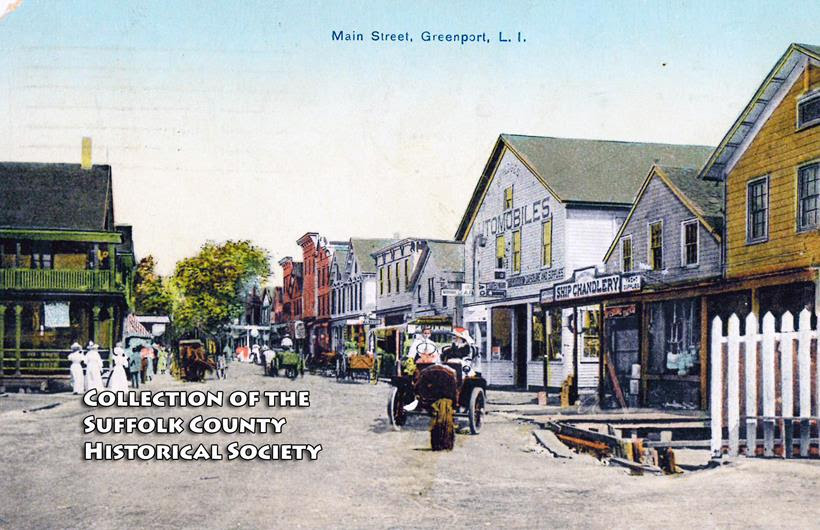
Main Street, Greenport. (Image from the Collection of the Suffolk County Historical Society Library Archives. Copyright © Suffolk County Historical Society. All rights reserved.)
In this early Greenport scene looking north on Main Street, we can see several familiar buildings, including where Claudio’s came to be on the left and where Preston’s is today on the right. Before Greenport became a major tourist destination on the North Fork of Long Island, it was a small maritime village. Settled in 1682, the village was called Winter Harbor, Stirling, and Green Hill, before being named Greenport in 1831 and being incorporated as the village of Greenport in 1838.
Because of its deep and protected harbor, Greenport became a major whaling port between 1795 and 1859, and enjoyed a bustling shipbuilding industry as well. By the mid-1800s, the menhaden fishing industry was in full swing and employed thousands of people. The Long Island Railroad arrived in 1844 and was a driving force in the development of Greenport and the North Fork, as local farmers used the railroad to ship their harvest to markets. During Prohibition, Greenport was a thriving center for rum running.
This weekend Greenport celebrates its maritime and shipbuilding heritage with its 30th Annual Maritime Festival, hosted by the East End Seaport and Marine Foundation in partnership with the Village of Greenport.
******************************************
Visit: www.suffolkcountyhistoricalsociety.org
To View 2014 Photo of the Week pages click here.
To View 2015 Photo of the Week pages click here.
To View 2016 Photo of the Week pages click here.
To View 2017 Photo of the Week pages click here.
To View 2018 Photo of the Week pages click here.
~~~~~~~~~~~~~~~~~~~~~~~~~~~~~~~~~~~~~~~~
PHOTO OF THE WEEK: September 14, 2019— FROM THE SCHS LIBRARY ARCHIVES
“How shall we know it is us without our past?”
– John Steinbeck
Nathan J. Cuffee, Montaukett
by Wendy Polhemus-Annibell, Head Librarian
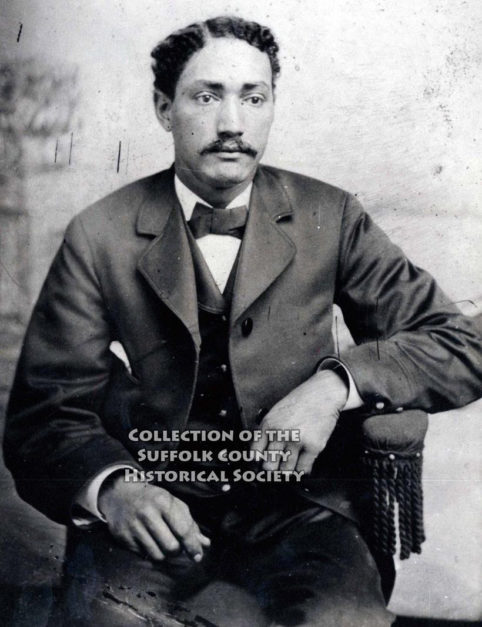
Portrait of Nathan J. Cuffee, c. 1900. (Image from the Long Island Indian Collection of the Suffolk County Historical Society Library Archives. Copyright © Suffolk County Historical Society. All rights reserved.)
Nathan J. Cuffee (1854-1912), a Montauk Indian who had been active in tribal affairs, was born to Louise Cotton Cuffee, a Narragansett, and Jason Cuffee, a Montaukett. Nathan’s son, the Rev. Aaron Cuffee, was a member of the Eastville band of the Sag Harbor Montauks. Nathan, who was blind, authored a book with Lydia Jocelyn, the wife of a Sioux missionary, whom he probably met when he lived in Eastville and was head of the Committee on Tribal Rights during the court struggle for the lands at Montauk. A mix of folklore, myth, and historical fiction titled Lords of the Soil (1903), the novel conveys a story about the early life of the Montauketts and their relations with the early English settlers.
The book’s authors were an unusual pair, drawn together by their shared interest in the historical relationship between Native Americans and European settlers. Jocelyn, 70 years old at the time of their collaboration, had lived for many years on a Sioux reservation and was an experienced author. Nathan Cuffee, twenty years younger than his co-author, was deeply involved in a court battle to reclaim the tribal lands at Montauk preempted in the 1880s by a group of powerful developers. According to John Strong, Nathan was probably the source for the novel’s historical settings and descriptions of native customs, making the work of interest to students of Long Island history.
In 1900, Nathan Cuffee testified before a Senate subcommittee about the loss of Shinnecock and Montauk land to the corporations involved in building the Long Island Rail Road. A year after Lords of the Soil was published, Cuffee and a small group of Montauks won a legal victory when an act of the state legislature enabled the Montauks to sue the railroad in state court. However, the court battle ended in 1917, a few years after Nathan’s death, with a decision for the railroad.
—————-
Suggested Readings: Nathan J. Cuffee and Lydia Jocelyn, Lords of the Soil (Boston: C. M. Clarke, 1905); John A. Strong, “Lost and Found,” Long Island Historical Journal, 3(2), Spring 1991: 253-58.
******************************************
Visit: www.suffolkcountyhistoricalsociety.org
To View 2014 Photo of the Week pages click here.
To View 2015 Photo of the Week pages click here.
To View 2016 Photo of the Week pages click here.
To View 2017 Photo of the Week pages click here.
To View 2018 Photo of the Week pages click here.
~~~~~~~~~~~~~~~~~~~~~~~~~~~~~~~~~~~~~~~~
PHOTO OF THE WEEK: September 7, 2019— FROM THE SCHS LIBRARY ARCHIVES
“How shall we know it is us without our past?”
– John Steinbeck
Wading River
by Wendy Polhemus-Annibell, Head Librarian
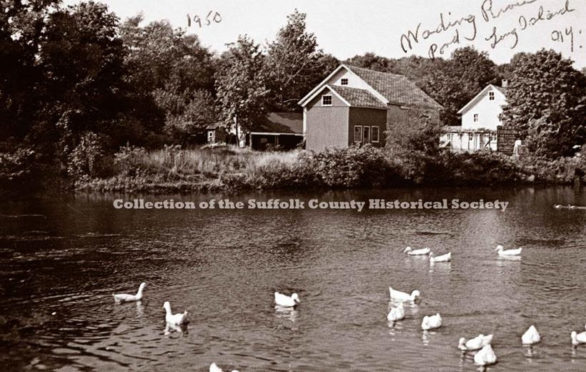
Wading River Pond, c. 1950. (Image from the Collection of the Suffolk County Historical Society Library Archives. Copyright © Suffolk County Historical Society. All rights reserved.)
The name Wading River is a simple English translation of the Indian name Pauquaconsuk, meaning “the place where we wade for thick, round-shelled clams.” The Brookhaven Town Records also provide an early reference to the hamlet known as Wading River:
On the 17th of November in the year of our Lord 1671, it was voted and agreed upon that there should be a settlement at the Wadeing River, of eight families…to have accommodations as the place will afford.
According to Evelyn Rowley Meir in The Wading River (1955), a pepperidge tree at Wading River figured prominently as a boundary between Brookhaven and Southold in many old records. The tree was not only a recognized mark between the towns, but was also a point used in laying out roads and separating other properties. Long gone, the tree stood on the eastern rim of the Wading River brook or pond, near the Wading River Congregational Church. In 1709, all the land on the east side of the river, which included much of the settlement at the time, was given to Southold Town. By the time Wading River became a part of the new town of Riverhead, formed in 1792, the hamlet was already more than a century old.
******************************************
Visit: www.suffolkcountyhistoricalsociety.org
To View 2014 Photo of the Week pages click here.
To View 2015 Photo of the Week pages click here.
To View 2016 Photo of the Week pages click here.
To View 2017 Photo of the Week pages click here.
To View 2018 Photo of the Week pages click here.
~~~~~~~~~~~~~~~~~~~~~~~~~~~~~~~~~~~~~~~~
PHOTO OF THE WEEK: August 30, 2019— FROM THE SCHS LIBRARY ARCHIVES
“How shall we know it is us without our past?”
– John Steinbeck
Long Island: America’s Sunrise Land
by Wendy Polhemus-Annibell, Head Librarian

Page from Long Island: America’s Sunrise Land, a tourism guide published in 1933 by the Passenger Traffic Department of the Pennsylvania Railroad, Penn Station, New York City.(From the Collection of the Suffolk County Historical Society Library Archives. Image copyright © Suffolk County Historical Society. All rights reserved.)
The Staff and Board of the Suffolk County Historical Society would like to wish all of our members, friends, and other supporters a happy and safe Labor Day weekend.
HOLIDAY CLOSURE: We will be closed on Saturday, August 31, 2019, for the Labor Day holiday. We will reopen on Wednesday, September 4, at 10:00 a.m.
———————–
The Staff and Board of the Suffolk County Historical Society would like to wish all of our members, friends, and other supporters a happy and safe Labor Day weekend.
******************************************
Visit: www.suffolkcountyhistoricalsociety.org
To View 2014 Photo of the Week pages click here.
To View 2015 Photo of the Week pages click here.
To View 2016 Photo of the Week pages click here.
To View 2017 Photo of the Week pages click here.
To View 2018 Photo of the Week pages click here.
~~~~~~~~~~~~~~~~~~~~~~~~~~~~~~~~~~~~~~~~
PHOTO OF THE WEEK: August 24, 2019— FROM THE SCHS LIBRARY ARCHIVES
“How shall we know it is us without our past?”
– John Steinbeck
Water Island, Fire Island
by Wendy Polhemus-Annibell, Head Librarian
Hotel and Boats at Water Island, Fire Island, 1901, by Hal B. Fullerton. (From the Harry T. Tuthill Fullerton Collection of the Suffolk County Historical Society Library Archives. Image copyright © Suffolk County Historical Society. All rights reserved.) [To view Hal B. Fullerton photograph, please visit www.SuffolkCountyHistoricalSociety.org.]
Water Island is not an island in the traditional sense. Rather, it’s a small, private community of residential homes on Fire Island, situated between Davis Park to the east and Fire Island Pines to the west. According to the Fire Island website, in 1878 the Pavilion restaurant, run by Richard Silsbee, stood where Water Island is today. Then, starting in the 1890s, Water Island was home to the prestigious White House Hotel, probably the hotel we see in the distance of this 1901 image by Hal B. Fullerton. The hotel was an elegant structure that became a favored destination for the socially elite of Blue Point and Bayport. Designed by Patchogue resident Edward Ryder, the White House Hotel was reportedly frequented by Theodore Roosevelt and his family.
Developed into a private residential community starting around 1912, Water Island was a hot destination for rum-runners during the Prohibition era. In fact, it’s claimed that during Prohibition the serving of alcohol and gambling took place openly at the White House Hotel.
******************************************
Visit: www.suffolkcountyhistoricalsociety.org
To View 2014 Photo of the Week pages click here.
To View 2015 Photo of the Week pages click here.
To View 2016 Photo of the Week pages click here.
To View 2017 Photo of the Week pages click here.
To View 2018 Photo of the Week pages click here.
~~~~~~~~~~~~~~~~~~~~~~~~~~~~~~~~~~~~~~~~
Page from Long Island: America’s Sunrise Land, a tourism guide published in 1933 by the Passenger Traffic Department of the Pennsylvania Railroad, Penn Station, New York City.(From the Collection of the Suffolk County Historical Society Library Archives. Image copyright © Suffolk County Historical Society. All rights reserved.)
The Staff and Board of the Suffolk County Historical Society would like to wish all of our members, friends, and other supporters a happy and safe Labor Day weekend.
HOLIDAY CLOSURE: We will be closed on Saturday, August 31, 2019, for the Labor Day holiday. We will reopen on Wednesday, September 4, at 10:00 a.m.
******************************************
Visit: www.suffolkcountyhistoricalsociety.org
To View 2014 Photo of the Week pages click here.
To View 2015 Photo of the Week pages click here.
To View 2016 Photo of the Week pages click here.
To View 2017 Photo of the Week pages click here.
To View 2018 Photo of the Week pages click here.
~~~~~~~~~~~~~~~~~~~~~~~~~~~~~~~~~~~~~~~~
PHOTO OF THE WEEK: August 17, 2019— FROM THE SCHS LIBRARY ARCHIVES
“How shall we know it is us without our past?”
– John Steinbeck
Old Mill at Hawley’s Pond
by Wendy Polhemus-Annibell, Head Librarian
———————————-
Old Mill at Hawley’s Pond, Babylon, 1899, by Hal B. Fullerton.(From the Harry T. Tuthill Fullerton Collection of the Suffolk County Historical Society Library Archives. Image copyright ©Suffolk County Historical Society. All rights reserved.) [To view Hal B. Fullerton photograph, please visit www.SuffolkCountyHistoricalSociety.org]
Constructed in circa 1750, the Old Mill at Hawley’s Pond was the first permanent structure in the area that would become the incorporated village of Babylon in 1893. The mill was built for Judge Garrett Montfort and was operated by the Oakley family for about a hundred years. Later it was owned by Nathaniel Conklin. In its final years, it was the site of a toy whip factory owned by David Ricketts, the second mayor or president of the village of Babylon. The factory, which moved to George Street, made colorful circus and carnival-type whips.
Suggested Reading: Babylon Village: Settled 1689 (Village of Babylon, n.d.).
******************************************
Visit: www.suffolkcountyhistoricalsociety.org
To View 2014 Photo of the Week pages click here.
To View 2015 Photo of the Week pages click here.
To View 2016 Photo of the Week pages click here.
To View 2017 Photo of the Week pages click here.
To View 2018 Photo of the Week pages click here.
~~~~~~~~~~~~~~~~~~~~~~~~~~~~~~~~~~~~~~~~
PHOTO OF THE WEEK: August 10, 2019— FROM THE SCHS LIBRARY ARCHIVES
“How shall we know it is us without our past?”
– John Steinbeck
Holstville Railroad Station
by Wendy Polhemus-Annibell, Head Librarian
Holstville Rail Road Station, 1899, by Hal B. Fullerton. [To View Please Visit www.SuffolkCountyHistoricalSociety.org] (From the Harry T. Tuthill Fullerton Collection of the Suffolk County Historical Society Library Archives. Image copyright © Suffolk County Historical Society. All rights reserved.)
Holtsville was a station stop on the Greenport Branch of the Long Island Rail Road, located near present-day Long Island Avenue and Furrows Road. The station first opened in a local store as the Waverly Station in the mid-1800s. The surrounding area was renamed Holtsville in 1860 when a post office was opened, but the rail road station retained the name “Waverly” until about 1890 because farmers had complained about their shipments being misdirected to an upstate town by the same name.
Holtsville Station was rebuilt in 1912 and again two years later. The station building was demolished in 1962, though the station-stop continued to operate until 1998, when the LIRR closed it due to low ridership.
******************************************
Visit: www.suffolkcountyhistoricalsociety.org
To View 2014 Photo of the Week pages click here.
To View 2015 Photo of the Week pages click here.
To View 2016 Photo of the Week pages click here.
To View 2017 Photo of the Week pages click here.
To View 2018 Photo of the Week pages click here.
~~~~~~~~~~~~~~~~~~~~~~~~~~~~~~~~~~~~~~~~
PHOTO OF THE WEEK: August 3, 2019— FROM THE SCHS LIBRARY ARCHIVES
“How shall we know it is us without our past?”
– John Steinbeck
Belmont Lake State Park, North Babylon
by Wendy Polhemus-Annibell, Head Librarian
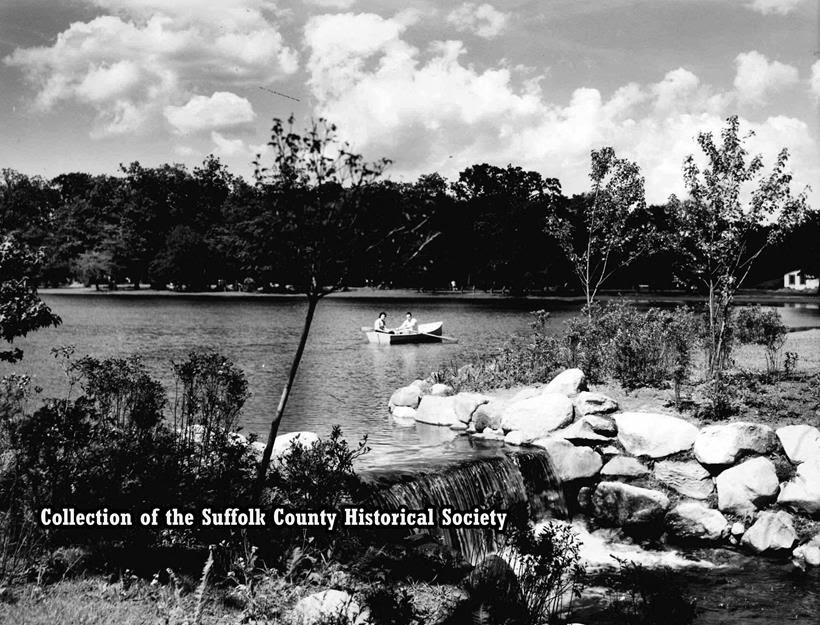
View of Belmont Lake State Park, North Babylon, 1934. (From the Collection of the Suffolk County Historical Society Library Archives. Image copyright © Suffolk County Historical Society. All rights reserved.)
Established in 1926 on land that was formerly part of a thoroughbred horse farm owned by August Belmont, namesake of the Belmont Stakes, Belmont Lake State Park occupies over 400 acres in North Babylon. In 1935, the park was selected by Robert Moses as regional headquarters for all state parks on Long Island. It has also served as the headquarters for the Long Island State Park Commission and Long Island State Parkway Police from the 1940s to about 1980.
The park now serves as the headquarters of the Long Island region of the NYS Office of Parks, Recreation, and Historic Preservation.
******************************************
Visit: www.suffolkcountyhistoricalsociety.org
To View 2014 Photo of the Week pages click here.
To View 2015 Photo of the Week pages click here.
To View 2016 Photo of the Week pages click here.
To View 2017 Photo of the Week pages click here.
To View 2018 Photo of the Week pages click here.
~~~~~~~~~~~~~~~~~~~~~~~~~~~~~~~~~~~~~~~~
PHOTO OF THE WEEK: July 27, 2019— FROM THE SCHS LIBRARY ARCHIVES
“How shall we know it is us without our past?”
– John Steinbeck
Miamogue House and Yacht Club
by Wendy Polhemus-Annibell, Head Librarian
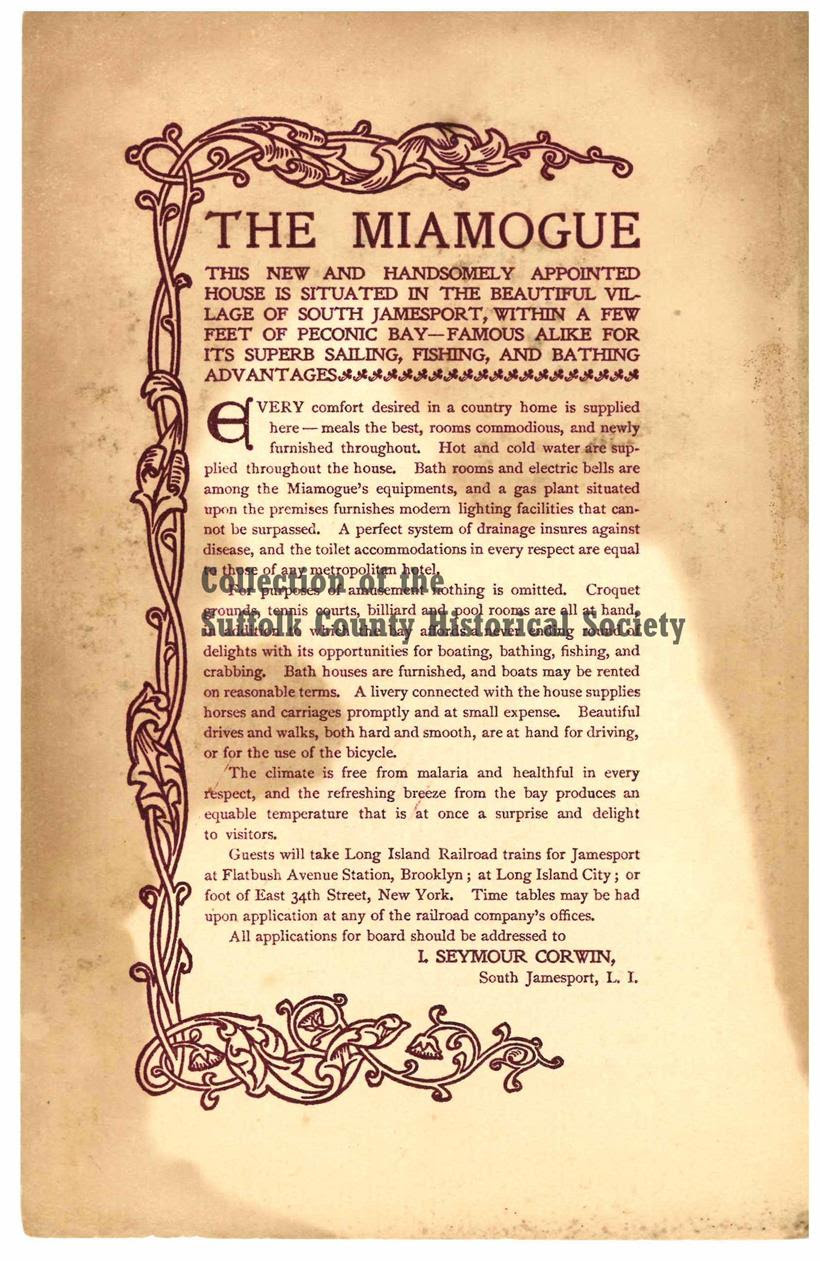
Advertisement: Miamogue Hotel, South Jamesport, c. 1880s. “This new and handsomely appointed house is situated in the beautiful village of South Jamesport, within a few feet of Peconic Bay–famous for its superb sailing, fishing, and bathing advantages…. The climate is free from malaria and healthful in every respect, and the refreshing breeze from the bay produces an equable temperature that is at once a surprise and delight to visitors.” (From the Collection of the Suffolk County Historical Society Library Archives. Image copyright © Suffolk County Historical Society. All rights reserved.)
————————————————–
Given its pleasant climate, good swimming, and excellent fishing, South Jamesport became a popular nineteenth-century summer resort area with hotels, parties, dances, moonlit sailing, and the like. This was especially true after the railroad made it possible for people from the city to reach the area relatively easily. Vacationers who arrived by train were met at the station by stages that carried the visitors to one of the hotels that had sprung up near Peconic Bay. The stages were open wagons with seats along the sides, a roof, side curtains, and a door at the back–and were capable of transporting ten to twenty passengers at a time.
The first hotel in South Jamesport was James Tuthill’s Inn, which stood on First Street between Main and Center streets. It burned to the ground, as did the Miamogue Inn in the same spot. Another Miamogue Inn was constructed here; it also caught fire and was torn down. The Sunnyside hotel was located south of the Miamogue, directly on the bay; and the Great Peconic Bay House was built by Captain Edward Downs at the end of Main Street on a point of land that jutted into the bay. His brother James Downs built the Locust Grove on Front Street. As more and more summer visitors purchased or built summer cottages near the shore in the twentieth century, the need for and number of hotels in the area diminished.
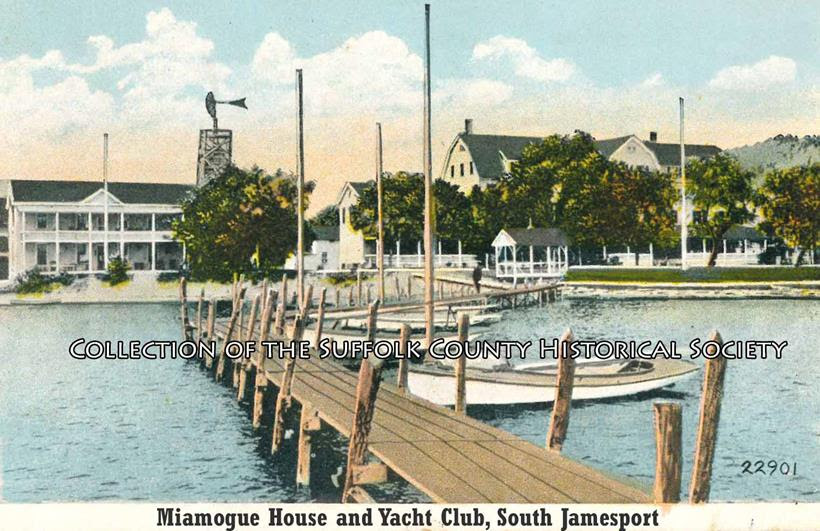
******************************************
Visit: www.suffolkcountyhistoricalsociety.org
To View 2014 Photo of the Week pages click here.
To View 2015 Photo of the Week pages click here.
To View 2016 Photo of the Week pages click here.
To View 2017 Photo of the Week pages click here.
To View 2018 Photo of the Week pages click here.
~~~~~~~~~~~~~~~~~~~~~~~~~~~~~~~~~~~~~~~~
PHOTO OF THE WEEK: July 20, 2019— FROM THE SCHS LIBRARY ARCHIVES
“How shall we know it is us without our past?”
– John Steinbeck
MIDDLE ISLAND PRESBYTERIAN CHURCH
by Wendy Polhemus-Annibell, Head Librarian
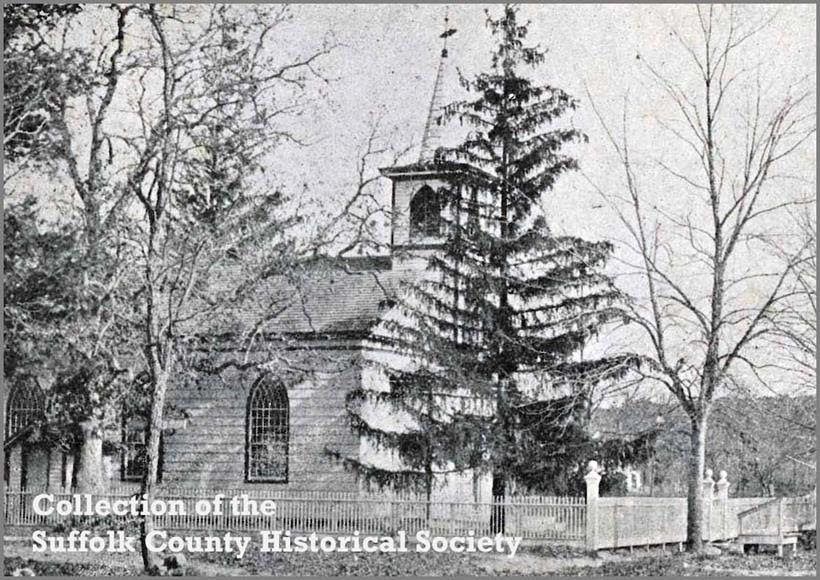
Middle Island Presbyterian Church. (From the Collection of the Suffolk County Historical Society Library Archives. Image Copyright © Suffolk County Historical Society. All rights reserved.)
In 1766, steps were taken to establish a church in Middle Island. Land was given by Selah Brown as a site for a meeting house, and the work of building a house of worship there was likely completed that same year. The Presbyterian church was organized in Middle Island in 1766.
The present-day church was built in 1837, and the tower and bell were added in 1863 and 1870, respectively. David Rose, the Presbyterian Church’s first pastor, served from 1767 to his death in 1799. Located at 271 Middle Country Road in Middle Island, today the historic church building serves as the Middle Island United Church of Christ, and is on the U.S. National Register of Historic Places.
******************************************
Visit: www.suffolkcountyhistoricalsociety.org
To View 2014 Photo of the Week pages click here.
To View 2015 Photo of the Week pages click here.
To View 2016 Photo of the Week pages click here.
To View 2017 Photo of the Week pages click here.
To View 2018 Photo of the Week pages click here.
~~~~~~~~~~~~~~~~~~~~~~~~~~~~~~~~~~~~~~~~
PHOTO OF THE WEEK: July 13, 2019— FROM THE SCHS LIBRARY ARCHIVES
“How shall we know it is us without our past?”
– John Steinbeck
1943 Grumman Calendar Book
by Wendy Polhemus-Annibell, Head Librarian

1943 Grumman Calendar Book. (From the Collection of the Suffolk County Historical Society Library Archives. Image Copyright © Suffolk County Historical Society. All rights reserved.)
Pictured on the January page of this 1943 Grumman calendar is the FF-1, Grumman’s first military plane for the U.S. Navy. It was also the world’s first military plane with retractable landing gear and a completely enclosed cockpit.
This two-place all metal biplane with a deep fusalage and equipped with arresting gear for service on aircraft carriers was superior to any fighter plane then in the service of the U.S. Navy. It was powered by a Wright cyclone, air-cooled engine, and boasted a top speed of 216 mph and a cruising range of 650 miles. Armament consisted of one machine gun firing through the propeller and one flexible machine gun in the rear cockpit.
From the FF-1, the SF-1 scout fighter was developed. FF-1s were delivered to Fighter Squadron VF-5B of the USS Lexingtonbeginning in June 1933. In service the FF-1 became familiarly known as the “Fifi.” Delivery of SF-1s started in 1934. Both the FF-1 and SF-1 were withdrawn from first-line U.S. Navy squadrons by the end of 1936 and reallocated to reserve units.
————————-
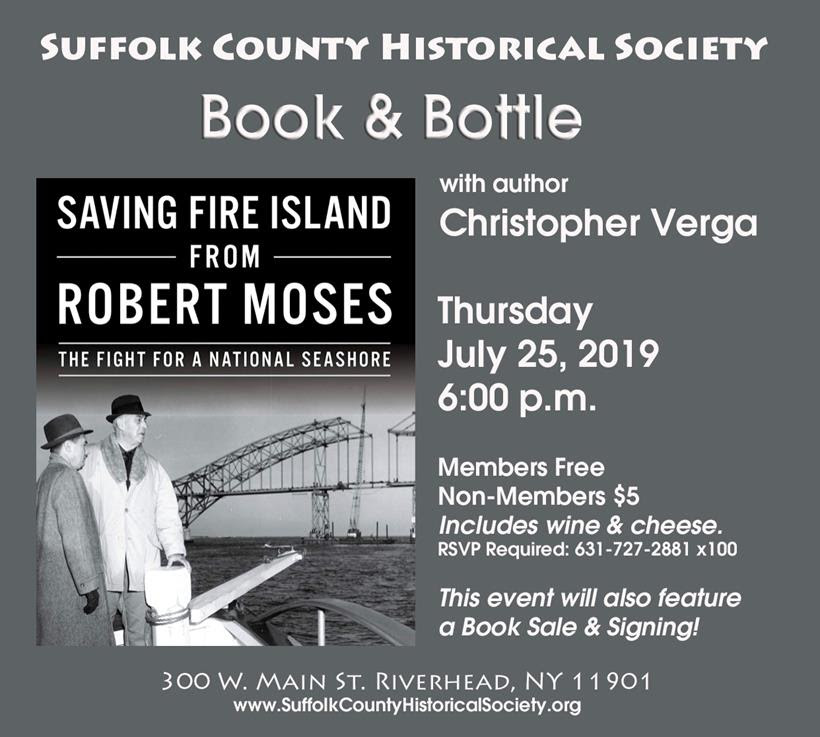
Join us for a BOOK & BOTTLE talk on Saving Fire Island from Robert Moses: The Fight for a National Seashore with author Christopher Verga on Thursday, July 25, 2019 at 6:00 pm. To developer Robert Moses, the Fire Island coastline was ripe for the construction of a four-lane highway, but standing up to his ambitions were the communities of Fire Island, unified in their love for their sun-washed sandy beaches and in their fight for federal protection through the creation of the Fire Island National Seashore. Author Chris Verga will discuss their triumphant struggle, the subject of his recently published book. Members Free; Non-Members $5. RSVP Required: 631-727-2881 x100. Includes wine & cheese + admission to current exhibits. This event will also feature a Book Sale and Signing!
******************************************
Visit: www.suffolkcountyhistoricalsociety.org
To View 2014 Photo of the Week pages click here.
To View 2015 Photo of the Week pages click here.
To View 2016 Photo of the Week pages click here.
To View 2017 Photo of the Week pages click here.
To View 2018 Photo of the Week pages click here.
~~~~~~~~~~~~~~~~~~~~~~~~~~~~~~~~~~~~~~~~
PHOTO OF THE WEEK: July 4, 2019— FROM THE SCHS LIBRARY ARCHIVES
“How shall we know it is us without our past?”
– John Steinbeck
July 4th Holiday Postcard
by Wendy Polhemus-Annibell, Head Librarian
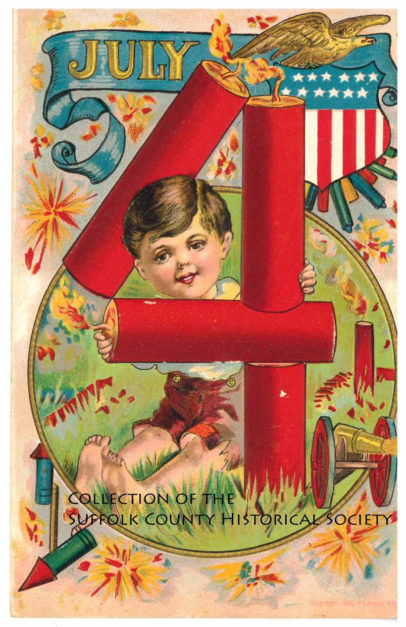
July 4th Holiday Postcard. (From the Collection of the Suffolk County Historical Society Library Archives. Image Copyright © Suffolk County Historical Society. All rights reserved.)
On July 4, 1776, the thirteen colonies claimed their independence from England, an event that eventually led to the formation of the United States of America. Each year on the Fourth of July, also known as Independence Day, Americans celebrate this historic event.
The Staff and Board of the Suffolk County Historical Society would like to wish all of our readers, members, and other supporters a happy and safe holiday celebration.
Holiday Closure: We will be closed on Thursday, July 4, 2019, for the holiday, and will reopen on Friday, July 5.
******************************************
Visit: www.suffolkcountyhistoricalsociety.org
To View 2014 Photo of the Week pages click here.
To View 2015 Photo of the Week pages click here.
To View 2016 Photo of the Week pages click here.
To View 2017 Photo of the Week pages click here.
To View 2018 Photo of the Week pages click here.
~~~~~~~~~~~~~~~~~~~~~~~~~~~~~~~~~~~~~~~~
PHOTO OF THE WEEK: June 29, 2019— FROM THE SCHS LIBRARY ARCHIVES
“How shall we know it is us without our past?”
– John Steinbeck
The Big Duck, Riverhead, c. 1930s
by Wendy Polhemus-Annibell, Head Librarian

The Big Duck, Riverhead, c. 1930s. (Image from the Riverhead Pictorial Collection of the Suffolk County Historical Society Library Archives. Copyright © Suffolk County Historical Society. All rights reserved.)
Riverhead duck farmer Martin Maurer and his wife Jeule decided to construct a giant duck-shaped duck shop in 1931. They hoped to sell the Peking ducks they raised to passing motorists who would be drawn to the unusual form of a “big duck” along Riverhead’s West Main Street. The Maurers hired carpenter George Reeve and stage show set designers William and Samuel Collins to construct the Big Duck. After the wooden frame had been pieced together, wire mesh was attached and cement was applied to the wire mesh. The Big Duck was painted white–except for the beak, of course, which was painted orange. The final touch was the placement of two Model-T taillights in the Big Duck’s head for eyes that would glow red at night.
The Big Duck measures 30 feet from beak to tail and stands 20 feet tall. It remained on West Main Street until 1936, when it was relocated to Route 24 in Flanders. Though it has moved several times since, the iconic Big Duck remains in Flanders today as a museum shop.
******************************************
Visit: www.suffolkcountyhistoricalsociety.org
To View 2014 Photo of the Week pages click here.
To View 2015 Photo of the Week pages click here.
To View 2016 Photo of the Week pages click here.
To View 2017 Photo of the Week pages click here.
To View 2018 Photo of the Week pages click here.
~~~~~~~~~~~~~~~~~~~~~~~~~~~~~~~~~~~~~~~~
PHOTO OF THE WEEK: June 22, 2019— FROM THE SCHS LIBRARY ARCHIVES
“How shall we know it is us without our past?”
– John Steinbeck
Manumission Application
by Wendy Polhemus-Annibell, Head Librarian

Application for the Manumission of Seviah, a Female Slave, by Uriah Hallock Jr. of Riverhead, June 28, 1808. (Image from the Collection of the Suffolk County Historical Society. Copyright © Suffolk County Historical Society. All rights reserved.)
In honor of this week’s Juneteenth, here is an image of a manumission application from our collection. Juneteenth is a nationally celebrated commemoration of the ending of slavery. Also known as Freedom Day, Juneteenth celebrates the June 19, 1865, announcement of the abolition of slavery in the state of Texas and more generally throughout the former Confederate states.
Manumissions (the freeing of slaves) increased during and after the American Revolution. In 1788, a manumission law was enacted that provided for freeing slaves but protected those who were elderly or ill from being freed without adequate provisions for their care. New York declared that all children born of slaves after July 4, 1799, were free, though the owners could retain the male child’s service until age twenty-eight and the female’s until age twenty-five. However, the slaveowner could also elect to abandon his claim to the child’s service and pass the responsibility for supporting the child to the state. In New York, a state law enacted in 1817 provided that by 1827 all slaves residing in the state would be considered free.
——————————————-

******************************************
Visit: www.suffolkcountyhistoricalsociety.org
To View 2014 Photo of the Week pages click here.
To View 2015 Photo of the Week pages click here.
To View 2016 Photo of the Week pages click here.
To View 2017 Photo of the Week pages click here.
To View 2018 Photo of the Week pages click here.
~~~~~~~~~~~~~~~~~~~~~~~~~~~~~~~~~~~~~~~~
PHOTO OF THE WEEK: June 15, 2019— FROM THE SCHS LIBRARY ARCHIVES
“How shall we know it is us without our past?”
– John Steinbeck
The Hulbert Flag
by Wendy Polhemus-Annibell, Head Librarian

The Hulbert Flag. (Image from the Collection of the Suffolk County Historical Society. Copyright © Suffolk County Historical Society. All rights reserved.)
In honor of Flag Day, here is an image of a controversial artifact from the Suffolk County Historical Society Museum’s permanent collection: the Hulbert flag. This flag is believed by some to have been made by Captain John Hulbert of Bridgehampton and carried by him and his militiamen from Fort Ticonderoga to Philadelphia in 1775–where, after having been seen by representatives at the Continental Congress, it might have influenced the design of the first American flag.
Found in the 1920s with some revolutionary war documents in a Bridgehampton attic and donated to our museum, the thirteen-star flag has been examined by a number of experts who remain divided over the oral tradition of the flag’s origins. The Hulbert flag nonetheless remains an interesting part of Suffolk County’s history as well as one of the best-known and most discussed artifacts in our museum’s collection. Come take a look! The museum is open Wednesday through Saturday, 10:00 a.m. to 4:30 p.m.
******************************************
Visit: www.suffolkcountyhistoricalsociety.org
To View 2014 Photo of the Week pages click here.
To View 2015 Photo of the Week pages click here.
To View 2016 Photo of the Week pages click here.
To View 2017 Photo of the Week pages click here.
To View 2018 Photo of the Week pages click here.
~~~~~~~~~~~~~~~~~~~~~~~~~~~~~~~~~~~~~~~~
PHOTO OF THE WEEK: June 10, 2019— FROM THE SCHS LIBRARY ARCHIVES
“How shall we know it is us without our past?”
– John Steinbeck
Block Island
by Wendy Polhemus-Annibell, Head Librarian
(To view Hal B. Fullerton Photo of the Week please visit SCHS website) Block Island Dock & Hotels, Rhode Island, 1905, by Hal B. Fullerton. (From the Harry T. Tuthill Fullerton Collection of the Suffolk County Historical Society Library Archives. Copyright © Suffolk County Historical Society. All rights reserved.)
In 1614, Dutch explorer Adrian Block sailed to this island and gave it his name: Block Island. The first European settlers, however, did not arrive until 1661. The Narragansett Indians were the first inhabitants of Block Island, as evidenced by remains that date back thousands of years. Their name for the island was “Manisses,” meaning “Island of the Little God.”
During the Revolutionary War, Block Islanders kept a lookout on Beacon Hill by lighting fires to warn that an enemy was in sight. In the 1800s, an observatory was built as a tourist attraction on Beacon Hill, which is Block Island’s highest point at over 200 feet above sea level. Home to several lighthouses, Block Island’s Northlight was built in 1867, and in 1873, the Southeast Light was constructed on a 150-foot-tall cliff. After years of erosion, the Southeast Lighthouse was just 50 feet from the cliff’s edge and had to be moved 245 feet back from the bluff at great expense. Today about 45 percent of Block Island is preserved open space.
******************************************
Visit: www.suffolkcountyhistoricalsociety.org
To View 2014 Photo of the Week pages click here.
To View 2015 Photo of the Week pages click here.
To View 2016 Photo of the Week pages click here.
To View 2017 Photo of the Week pages click here.
To View 2018 Photo of the Week pages click here.
~~~~~~~~~~~~~~~~~~~~~~~~~~~~~~~~~~~~~~~~
PHOTO OF THE WEEK: June 1, 2019— FROM THE SCHS LIBRARY ARCHIVES
“How shall we know it is us without our past?”
– John Steinbeck
Walt Whitman’s Homestead
by Wendy Polhemus-Annibell, Head Librarian

Walt Whitman’s Home in Huntington. (From the Collection of the Suffolk County Historical Society Library Archives. Copyright © Suffolk County Historical Society. All rights reserved.)
The well-known American poet Walt Whitman lived in many places — Brooklyn, Washington, New Jersey — but Long Island was his home. Born on his family’s West Hills (Huntington) farm 200 years ago, on May 31, 1819, Whitman’s family roots on Long Island went back generations. His great-grandfather Nehemiah owned several hundred acres of farmland in the area, and his father Walter built the family farmhouse in 1810. His mother’s family, the Van Velsors, lived in nearby Cold Spring. As a child, Walt Whitman learned to love horses and horseback riding at his mother’s family’s farm, and from a maternal grandfather he heard stories of naval battles and whaling voyages.
The family moved to Brooklyn when Walt was a young boy, but he continued to spend his summers on Long Island. Later he would teach school in Smithtown, in Babylon, and in several other Long Island towns. Whitman’s educational philosophies caused some uproar in these places, for unlike most educators of the time period, Whitman believed children were best taught through love and encouragement, not fear and punishments.
Whitman’s next venture was to acquire ownership of the Long-Islander, a local newspaper, and to write for and publish it for some time, distributing the paper in a horse-drawn wagon. His first book, just 12 poems and a preface when first released in 1855, he called Leaves of Grass. Each subsequent book included more poems, but always the title remained the same: Leaves of Grass.
The Walt Whitman house today, a weathered brown-shingled farmhouse, is a landmark and a museum.
******************************************
Visit: www.suffolkcountyhistoricalsociety.org
To View 2014 Photo of the Week pages click here.
To View 2015 Photo of the Week pages click here.
To View 2016 Photo of the Week pages click here.
To View 2017 Photo of the Week pages click here.
To View 2018 Photo of the Week pages click here.
~~~~~~~~~~~~~~~~~~~~~~~~~~~~~~~~~~~~~~~~
PHOTO OF THE WEEK: May 25, 2019— FROM THE SCHS LIBRARY ARCHIVES
“How shall we know it is us without our past?”
– John Steinbeck
Jones Beach Water Circus, 1934
by Wendy Polhemus-Annibell, Head Librarian

Jones Beach Water Circus, 1934. (From the Collection of the Suffolk County Historical Society Library Archives. Copyright © Suffolk County Historical Society. All rights reserved.)
Here’s a 1934 image of the Jones Beach Water Circus on Zachs Bay for the Memorial Day holiday. The Long Island State Park Commission event was intended to liven up the usual swimming races and high diving competitions by featuring elephant and clown acts, acrobats, and fire divers from a high platform–all interspersed with the swimming races. These events were entirely for free and drew tens of thousands of spectators to Jones Beach. The wood structure shown in the image was destroyed in a hurricane in 1937, and was eventually replaced by the Jones Beach Theater.
As a reminder, we will be closed tomorrow, Saturday, May 25, for the Memorial Day weekend, and wish our readers, members, and supporters a safe and enjoyable holiday.
******************************************
Visit: www.suffolkcountyhistoricalsociety.org
To View 2014 Photo of the Week pages click here.
To View 2015 Photo of the Week pages click here.
To View 2016 Photo of the Week pages click here.
To View 2017 Photo of the Week pages click here.
To View 2018 Photo of the Week pages click here.
~~~~~~~~~~~~~~~~~~~~~~~~~~~~~~~~~~~~~~~~
PHOTO OF THE WEEK: May 18, 2019— FROM THE SCHS LIBRARY ARCHIVES
“How shall we know it is us without our past?”
– John Steinbeck
Tombs Prison, NYC, 1898
by Wendy Polhemus-Annibell, Head Librarian
[To view the Hal B. Fullerton photo, please visit the Suffolk County Historical Society’s website] Tombs Prison, NYC, 1898–by Hal B. Fullerton. (Image from the Harry T. Tuthill Fullerton Collection of the Suffolk County Historical Society Library Archives. Copyright © Suffolk County Historical Society. All rights reserved.)
Serving as one of New York City’s primary prisons for more than a half century, the so-called Halls of Justice and House of Detention was more commonly known as the Tombs. The massive edifice of granite, designed by architect John Haviland, was built between 1835 and 1838. Its design was rumored to have been inspired by an ancient Egyptian mausoleum. The building was 253 x 200 feet in size and occupied Centre, Franklin, Elm (today’s Lafayette), and Leonard Streets in downtown Manhattan. The Tombs initially accommodated 300 prisoners.
The building was sited on a former colonial-era pond that had been drained and filled in in the early 1800s. The heavy masonry of Haviland’s design was built atop vertical piles of hemlock tree trunks for stability, but within a decade the entire structure began to sink. The damp foundation was partly responsible for the prison’s unsanitary conditions during the decades that followed. By 1902, the Tombs had been replaced by a new eight-story city prison.
————————————
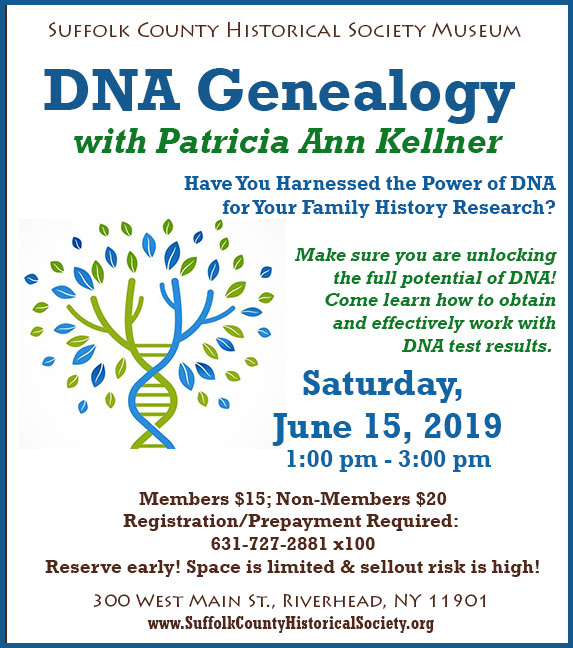
Join us on Saturday, June 15 at 1:00 PM for a lecture and talk on DNA Genealogy with Patricia Ann Kellner. Learn how to harness the power of DNA for your family history research. DNA tests, such as AncestryDNA and 23andMe, are important tools in the quest to find your family and its origins–as well as to gain health insights. Patricia Ann Kellner, President of the DNA Genealogy Group of Long Island, has found lost family members and reunited adoptees to their families using Genealogy and DNA. She will share her successful Genetic Genealogy strategies. Members $15; Non-Members $20. Paid Reservation Required: 631-727-2881 x100.
******************************************
Visit: www.suffolkcountyhistoricalsociety.org
To View 2014 Photo of the Week pages click here.
To View 2015 Photo of the Week pages click here.
To View 2016 Photo of the Week pages click here.
To View 2017 Photo of the Week pages click here.
To View 2018 Photo of the Week pages click here.
~~~~~~~~~~~~~~~~~~~~~~~~~~~~~~~~~~~~~~~~
PHOTO OF THE WEEK: May 11, 2019— FROM THE SCHS LIBRARY ARCHIVES
“How shall we know it is us without our past?”
– John Steinbeck
US Life-Saving Station, East Quogue, 1904
by Wendy Polhemus-Annibell, Head Librarian

U.S. Life-Saving Station, East Quogue, 1904. (Image from the Southampton Pictorial Collection of the Suffolk County Historical Society Library Archives. Copyright © Suffolk County Historical Society. All rights reserved.)
Early life-saving stations were run entirely by volunteers. Local baymen and farmers lived at the stations from October until May to patrol the coastline for stranded ships and perform rescues when needed. After decades of public outrage over fatal shipwrecks along the Atlantic Coast, however, the U.S. Congress finally acted, in 1871, to appropriate funds to create a federal life-saving system. The provision allowed the Secretary of the Treasury to build new life-saving stations and employ crews to man them. Sumner Kimball served as General Superintendent of the United States Life-Saving Service (USLSS) from the day it was formed to the day it ended in 1915. Kimball began by organizing the new USLSS into thirteen districts from Maine to Florida, to the Gulf Coast and the Pacific, and north to the Great Lakes. Long Island was designated as District 4, and by 1914 it had 30 life-saving stations.
The stations along the Atlantic Coast were continually threatened by wind and encroachment of the sea, forcing the stations to be moved back from the ocean. In 1877, the Jones Beach station was hit by a storm that forced abandonment of the building when the ocean tore the station from its foundation and began to carry it away, requiring the crew to anchor their station like a ship to save it. The USLSS realized it could never withstand the powers of the sea, so it made its stations moveable. The stations of New York were built in the classic pattern of three to five miles apart. Beach patrols and lookouts covered the coastline, and the close proximity of the stations allowed for joint rescue missions involving two or more stations. New York was the only state to have life-saving stations on both the ocean and the Great Lakes.
There were 279 stations in the United States by the end of the Life-Saving Service in 1915, when the newly created U.S. Coast Guard took control of the stations.
******************************************
Visit: www.suffolkcountyhistoricalsociety.org
To View 2014 Photo of the Week pages click here.
To View 2015 Photo of the Week pages click here.
To View 2016 Photo of the Week pages click here.
To View 2017 Photo of the Week pages click here.
To View 2018 Photo of the Week pages click here.
~~~~~~~~~~~~~~~~~~~~~~~~~~~~~~~~~~~~~~~~
PHOTO OF THE WEEK: May 4, 2019— FROM THE SCHS LIBRARY ARCHIVES
“How shall we know it is us without our past?”
– John Steinbeck
Southold Town’ 300th Anniversary Parade, 1940
by Wendy Polhemus-Annibell, Head Librarian

Southold Anniversary Parade, July 3, 1940. (Image from the Josiah Case Collection of the Suffolk County Historical Society Library Archives. Copyright © Suffolk County Historical Society. All rights reserved.)
John and Lillian Howell of Southold are shown here riding in their 1905 Oldsmobile Curved Dash Runabout at the 300th Anniversary Parade of the Town of Southold in July 1940. John Howell purchased this vehicle in the spring of 1905, the first automobile ever owned by a resident of Southold, and he later donated the Oldsmobile to our museum, where it is on permanent exhibit in our Suffolk Transport gallery.
The Tercentenary Celebration of Southold Town included an entire week of planned events from June 30 through July 7 across the town, from Laurel to Orient. The Grand Parade took place in Southold hamlet on July 3 at 2:30 p.m., “predicted to be a most impressive and beautiful march of floats and entries,” according to the anniversary program. After the parade an assembly took place on the Southold school grounds. Distinguished guests were introduced by Supervisor S. Wentworth Horton, there was a massing of the colors by the American Legion, and music selections were played by five high school bands. The rest of the day’s celebrations featured swimming races at Southold Town Beach, an antique exhibition at Mattituck High School, an archaeological exhibition at Cutchogue School, and an art exhibit at Peconic School.
**********************
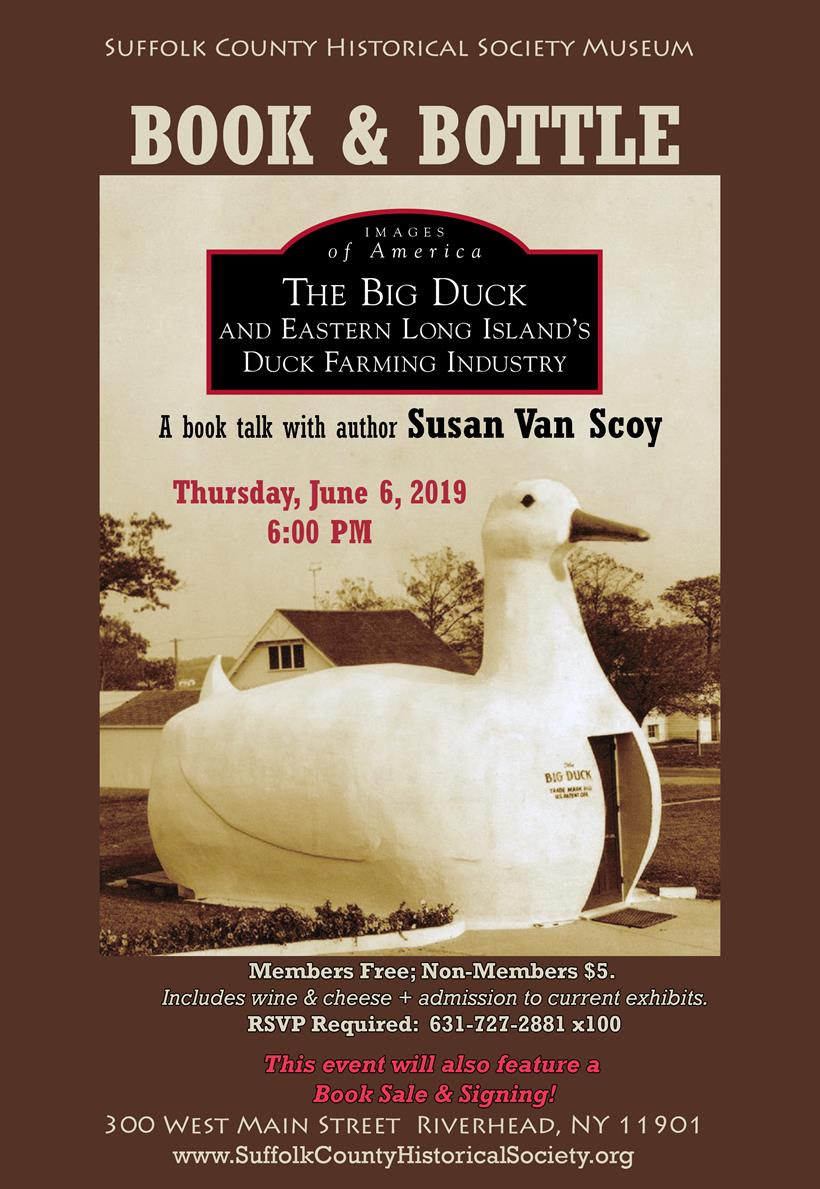
Join us on Thursday, June 6 at 6:00 PM for a book talk with author Susan Van Scoy on The Big Duck & Eastern Long Island’s Duck Farming Industry. The author will trace the fascinating and largely unknown history of Long Island’s iconic Big Duck! Dr. Van Scoy is a professor of art history at St. Joseph’s College specializing in the history of photography and site-specific art. Her recently published book, The Big Duck, will be available for purchase and author signing at this event. Members Free; Non-Members $5. RSVP Required: 631-727-2881 x100.
————————————————

NEW ACCESSIBILITY ENTRANCE
We are proud to announce the Grand Opening of our new entrance wing! Our new reception entrance incorporates all ADA-compliant handicap accommodations, including elevator, restrooms, and on-site handicap parking, improving access for all! This project was made possible through major funding from the Robert David Lion Gardiner Foundation, New York State Council on the Arts, and Empire State Development.
******************************************
Visit: www.suffolkcountyhistoricalsociety.org
To View 2014 Photo of the Week pages click here.
To View 2015 Photo of the Week pages click here.
To View 2016 Photo of the Week pages click here.
To View 2017 Photo of the Week pages click here.
To View 2018 Photo of the Week pages click here.
~~~~~~~~~~~~~~~~~~~~~~~~~~~~~~~~~~~~~~~~
PHOTO OF THE WEEK: April 12, 2019— FROM THE SCHS LIBRARY ARCHIVES
“How shall we know it is us without our past?”
– John Steinbeck
Godey’s Lady’s Book
by Wendy Polhemus-Annibell, Head Librarian

Godey’s Lady’s Book, April 1864 (Vol. LXVIII), Edited by Sarah J. Hale and L. A. Godey. (From the Collection of the Suffolk County Historical Society Library Archives. Copyright © Suffolk County Historical Society. All rights reserved.)
—————————-
In Philadelphia in 1830, Louis Antoine Godey (1804-1878) began publishing Godey’s Lady’s Book, a magazine intended to entertain, inform, and educate the women of America. In addition to extensive fashion content and beautiful illustrations–including hand-colored fashion plates, engravings, and woodcuts–the early issues included biographical sketches and articles about crafts, costume, dance, health and hygiene, recipes, and remedies. Gradually, the periodical also became a literary magazine, publishing extensive book reviews alongside the poems, essays, and short stories of well-known nineteenth-century writers, such as Harriet Beecher Stowe, Edgar Allan Poe, Nathaniel Hawthorne, and Henry Wadsworth Longfellow.
In 1836, Godey purchased American Ladies’ Magazine, which he merged with his own publication. Significantly, Sarah Josepha Hale (1788-1879) became the new editor of Godey’s Lady’s Book, writing frequently about the notion of the “women’s sphere.” “The greatest triumph of this progression,” she wrote, “is redeeming woman from her inferior position and placing her side by side with man.” Hale’s devotion to her work and her editorial principles regarding social inequalities and the education of American women made her one of the most important editors of the time period. The magazine flourished under her leadership, reaching a pre-Civil War circulation of 150,000. For the over 40 years that Godey and Hale worked together, they were a major force in American publishing. Today, Godey’s Lady Book is considered an important information resource for the study of nineteenth-century American life and culture. (Several dozen issues are held within our own library collection.)
Be sure to join us tomorrow afternoon, Saturday, April 13, beginning at 1:00 pm, for an exhibit opening reception for When Women Wore Whales: The Story of How Whalebone Shaped 19th-Century Fashion. Featuring photographs, whaling tools, corsets, parasols, exquisite dresses, and Godey’s Lady’s Book fashion magazine plates, this exhibit explores the fascinating and vital role the U.S. whaling industry played in the 19th-century fashion industry. Admission is free to all on opening day, and light refreshments will be served.
~~~~~~~~~~~~~~~~~~~~~~~~~~~~~~
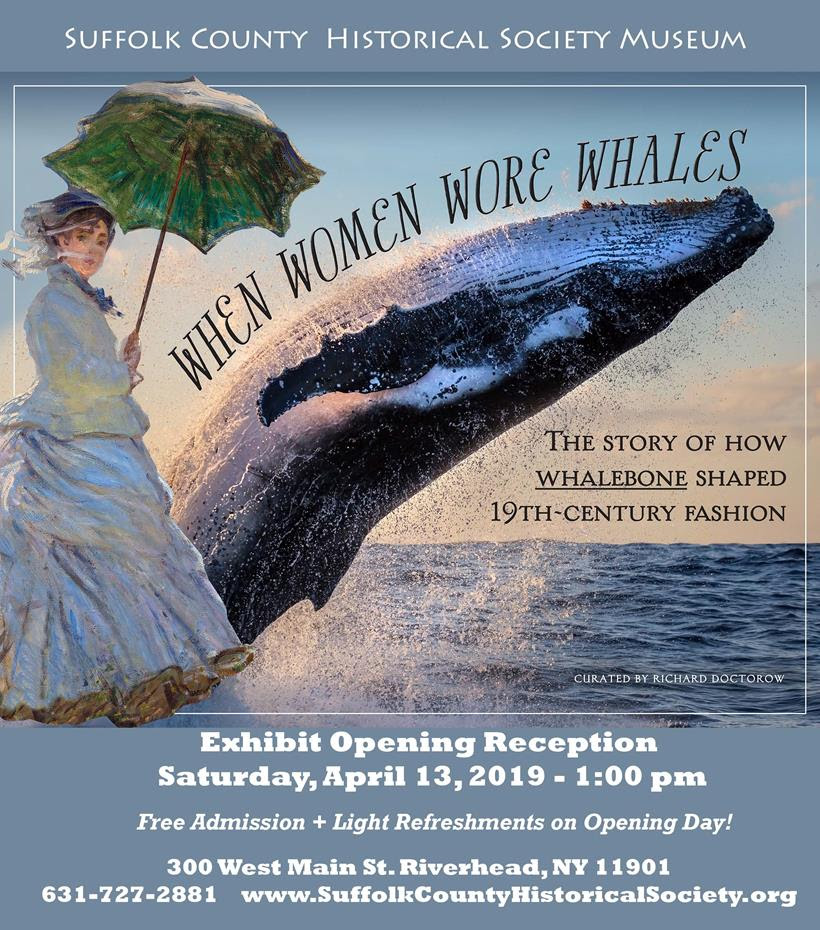
******************************************
Visit: www.suffolkcountyhistoricalsociety.org
To View 2014 Photo of the Week pages click here.
To View 2015 Photo of the Week pages click here.
To View 2016 Photo of the Week pages click here.
To View 2017 Photo of the Week pages click here.
To View 2018 Photo of the Week pages click here.
~~~~~~~~~~~~~~~~~~~~~~~~~~~~~~~~~~~~~~~~
PHOTO OF THE WEEK: April 6, 2019— FROM THE SCHS LIBRARY ARCHIVES
“How shall we know it is us without our past?”
– John Steinbeck
Suffolk County Historical Society Postcard Collection
by Wendy Polhemus-Annibell, Head Librarian
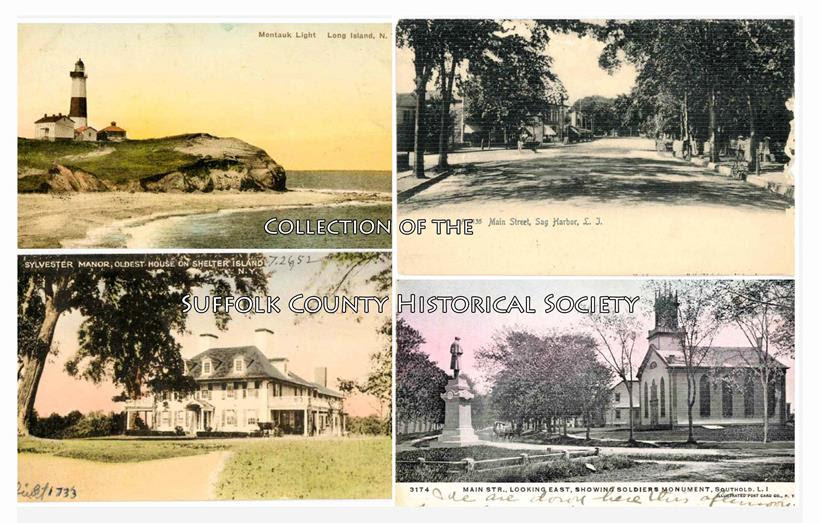
Images from the SCHS Postcard Collection. (From the Collection of the Suffolk County Historical Society Library Archives. Copyright © Suffolk County Historical Society. All rights reserved.)
Back in the early decades of the twentieth century, when it cost a penny for a stamp, postcards were a popular way to share holiday greetings with friends and family. We want to thank everyone who made it out to “A Penny Postcard View of Long Island” by Noel Gish today. For those who could not attend the event, here are reproductions of a few historic Long Island postcards along with the speaker’s Chronology of the Postcard:
1869 – Austria issues the first postcards.
1893 – The U.S. government issues penny postcards showing views of the Columbian Exposition in Chicago.
1898 – An Act of Congress permits private manufacturers to make postcards, with the back restricted to the mailing address and stamp only. These were called “private mailing cards.”
1901 – Regular 3-1/2″ x 5-1/2″ postcards begin. These are generally referred to as “undivided backs” because the entire back was still reserved for the address and stamp. It was about this time that the postcard craze began in America.
1907 – The U.S. Postmaster General allowed a vertical line to be drawn on the back of postcards so that a message could be written on the left side and the address on the right.
1917 – After World War I, the finest American postcards, printed in Germany, were no longer available. Most postcards issued after this date were American made and of comparatively lesser quality.
1930 – A new type of postcard called the “linen” was introduced, probably the ugliest type of postcard ever made. The linen effect on the surface of the card made clarity of detail nearly nonexistent.
1940 – The chrome card was introduced. It had a smooth, glossy finish, but the description was put on the back of the cards instead of the front, making them less attractive to collectors.
1970 – The king-sized chrome postcard was being used in the United States, with captions returned to the front of the card. The picture was clearer, and the size was generally 4″ x 5-7/8″.
————————–
HOLIDAY CLOSURE NOTICE:
SCHS will be closed on Saturday, April 20, 2019, and will reopen on Wednesday, April 24, at 10:00 a.m.
******************************************
Visit: www.suffolkcountyhistoricalsociety.org
To View 2014 Photo of the Week pages click here.
To View 2015 Photo of the Week pages click here.
To View 2016 Photo of the Week pages click here.
To View 2017 Photo of the Week pages click here.
To View 2018 Photo of the Week pages click here.
~~~~~~~~~~~~~~~~~~~~~~~~~~~~~~~~~~~~~~~~
PHOTO OF THE WEEK: March 30, 2019— FROM THE SCHS LIBRARY ARCHIVES
“How shall we know it is us without our past?”
– John Steinbeck
Frank Hurley Collection
by Wendy Polhemus-Annibell, Head Librarian
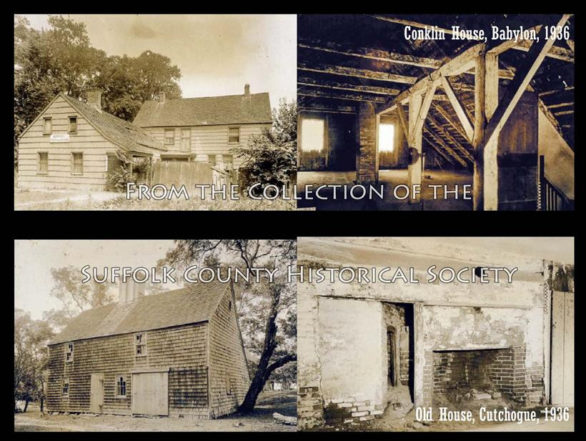
Images from the Frank Hurley Collection. (From the Collection of the Suffolk County Historical Society Library Archives. Copyright © Suffolk County Historical Society. All rights reserved.)
Our Frank Hurley Collection includes hundreds of photographs and documentation of historic houses across Long Island from the early twentieth century. Frank E. Hurley Jr. was an architect who resided in East Meadow and Baldwin. Much of this collection represents his 1930s WPA (Works Progress Administration) work as an Assistant Project Supervisor for the Historic American Buildings Survey (HABS), which aimed to study, measure, and record early American architecture.
In addition to photographs of homes and some businesses in Suffolk County – both exterior and interior shots – the Frank Hurley Collection includes images of structures in Nassau County, Brooklyn, Queens, and Manhattan. Shown here are 1936 exterior/interior images of historic homes in Babylon (the Conklin House) and Cutchogue (the Old House, referred to as the “Horton-Wickham-Landon House”). The collection includes over 500 photographs along with Hurley’s notes.
**************
HOLIDAY CLOSURE NOTICE: SCHS will be closed on Sat., April 20, 2019, and will reopen on Weds., April 24 at 10:00 a.m.
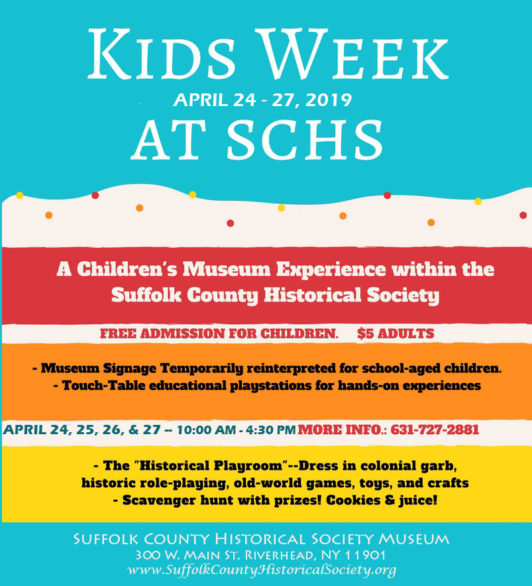
******************************************
Visit: www.suffolkcountyhistoricalsociety.org
To View 2014 Photo of the Week pages click here.
To View 2015 Photo of the Week pages click here.
To View 2016 Photo of the Week pages click here.
To View 2017 Photo of the Week pages click here.
To View 2018 Photo of the Week pages click here.
~~~~~~~~~~~~~~~~~~~~~~~~~~~~~~~~~~~~~~~~
~~~~~~~~~~~~~~~~~~~~~~~~~~~~~~~~~~~~~~~~
PHOTO OF THE WEEK: March 23, 2019— FROM THE SCHS LIBRARY ARCHIVES
“How shall we know it is us without our past?”
– John Steinbeck
Orville Young Photograph Collection
by Wendy Polhemus-Annibell, Head Librarian
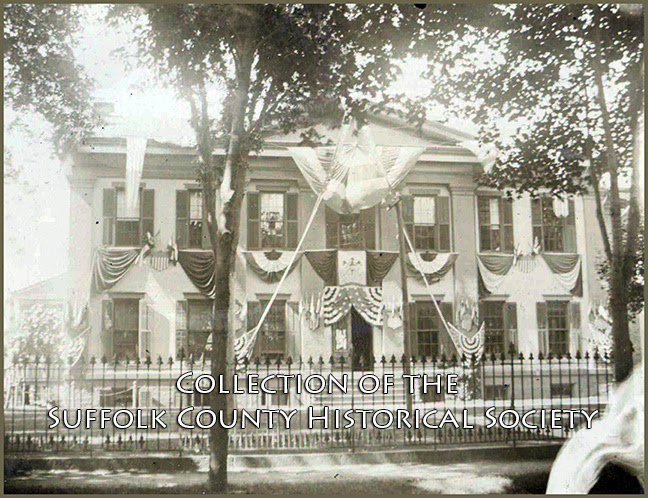
Suffolk County Courthouse in Riverhead, 1897, from the Orville Young Photograph Collection. (Image from the Collection of the Suffolk County Historical Society Library Archives. Copyright © Suffolk County Historical Society. All rights reserved.)
Our Orville Young Photograph Collection is an exceptional collection of images documenting the history and changing landscape of Suffolk County. The Youngs were residents of Riverhead, where Orville Young’s father, John Young (1845-1906), operated a planing and moulding mill. Orville Young (1876-1961) worked at his father’s mill, later inventing and building a number of early electrical engines. The Young mill was destroyed by fire in 1902, and was later replaced by Orville’s machine shop. John Elliot Young Jr. (1905-1987), Orville’s son, continued the business his father built until his own death in the 1980s
Both father and son had a keen interest in photography, amassing over a thousand images documenting life on Long Island, with a particular focus on Suffolk County and the eastern end of the island. The collection includes images of Southold, Westhampton, Jamesport, Greenport, and many other locations, with the largest number of images documenting the vicinity in and around Riverhead. The subjects range from panoramic views of Riverhead taken from atop the old water tower and the Riverhead band on parade to images of farming and family life in the town. The collection is available to view in our library archives, Wednesday to Saturday, 12:30 pm to 4:30 pm. No appointment is necessary.

******************************************
Visit: www.suffolkcountyhistoricalsociety.org
To View 2014 Photo of the Week pages click here.
To View 2015 Photo of the Week pages click here.
To View 2016 Photo of the Week pages click here.
To View 2017 Photo of the Week pages click here.
To View 2018 Photo of the Week pages click here.
~~~~~~~~~~~~~~~~~~~~~~~~~~~~~~~~~~~~~~~~
PHOTO OF THE WEEK: March 16, 2019— FROM THE SCHS LIBRARY ARCHIVES
“How shall we know it is us without our past?”
– John Steinbeck
Flora of the Peconic River by Oren S. Ryker
by Wendy Polhemus-Annibell, Head Librarian

Flora of the Peconic River, by Oren S. Ryker. (Images from the Oren S. Ryker Collection of the Suffolk County Historical Society Library Archives. Copyright © Suffolk County Historical Society. All rights reserved.)
The Suffolk County Historical Society’s Oren S. Ryker Collection was donated by the photographer in the 1970s. The images–over a hundred of them–depict native and non-native plant life growing along the shores of the Peconic River. The New Britton and Brown Illustrated Flora of the Northeastern United States (3 vols., NY Botanical Garden, 1952) was used by Oren Ryker to identify the plants by their Latin names. The above images are labeled as follows: Top row–Asclepia tuberosa (yellow butterfly weed), Asclepias syriaca (milkweed), Asclepias tuberosa (orange butterfly weed). Bottom row–Lechea maritima (beach pinweed), Iris versicolor (Blue flag iris), Lythrum salicaria (loosestrife).
Oren S, Ryker was born in Parsons, Kansas, in 1900, and by 1928 he was living with his wife in Riverhead. An accountant who enjoyed expressing his love of nature through photography, Ryker befriended noted botanical photographer Samuel Gottsho, and the two friends spent countless hours together canoeing and taking photographs along the Peconic River.
Ryker photographed these botanical images on large-sized, 2¼-inch Kodak Ektachrome transparency film. Ektachrome, initially developed in the early 1940s, allowed professionals and amateurs alike to process their own films. It also made color reversal film more practical in larger formats. Unlike the development process used by Kodachrome (technically intricate and beyond the means of amateur photographers and smaller photographic labs), Ektachrome processing was much simpler, and small professional labs could afford equipment to develop the film.
Over fifty images from the Oren S. Ryker Collection are currently on display in our festive Oh, Sweet Spring! exhibit, which runs until June 1, 2019, in our Gish Gallery. The images are also available for viewing in our library archives, Weds. – Sat., 12:30 pm to 4:30 pm.
~~~~~~~~~~~~~~~~~~~~~~~~~~~~~~~~~~~~~`
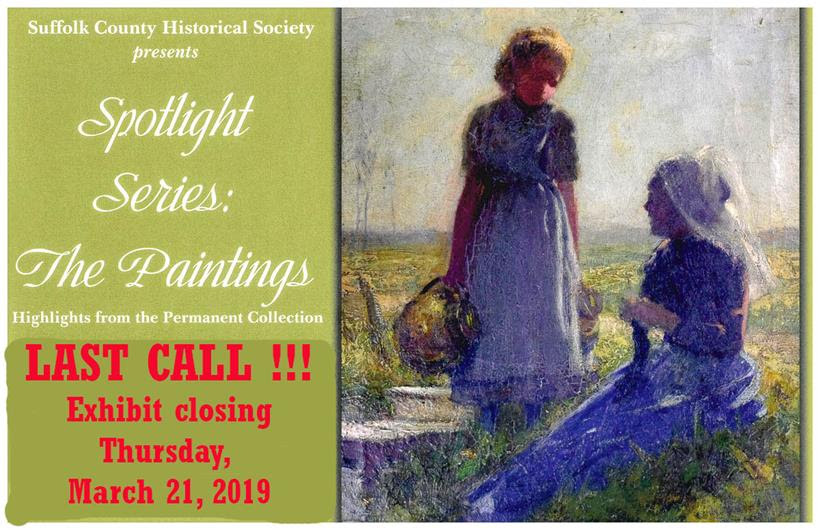
Gallery Hours: Weds. – Sat., 10: am – 4:30 pm
******************************************
Visit: www.suffolkcountyhistoricalsociety.org
To View 2014 Photo of the Week pages click here.
To View 2015 Photo of the Week pages click here.
To View 2016 Photo of the Week pages click here.
To View 2017 Photo of the Week pages click here.
To View 2018 Photo of the Week pages click here.
~~~~~~~~~~~~~~~~~~~~~~~~~~~~~~~~~~~~~~~~
PHOTO OF THE WEEK: March 9, 2019— FROM THE SCHS LIBRARY ARCHIVES
“How shall we know it is us without our past?”
– John SteinbeckElizabeth Cady Stanton
by Wendy Polhemus-Annibell, Head Librarian
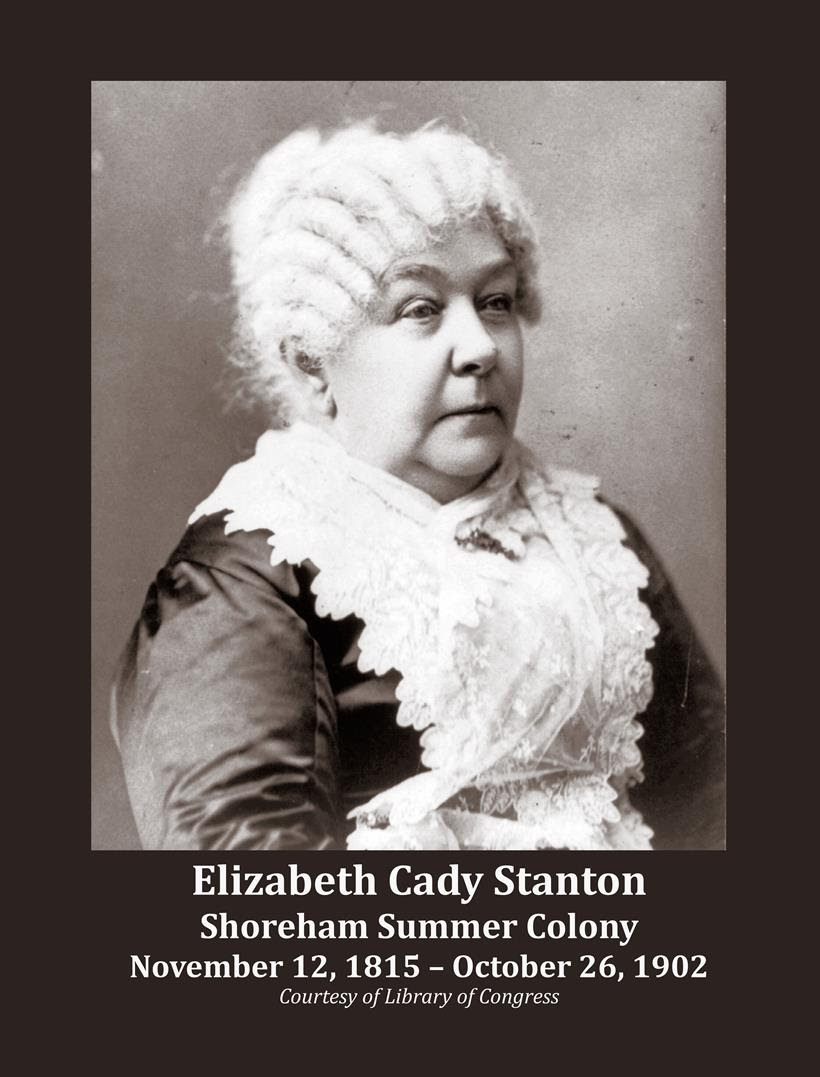
WOMEN’S HISTORY MONTH: Elizabeth Cady Stanton (1815 – 1902)
Though Elizabeth Cady Stanton did not live to see New York women win voting rights in 1917, she was an early American suffragist, social activist, abolitionist, and leading figure of the early women’s rights movement in New York State. Her Declaration of Sentiments, presented at the Seneca Falls Convention held in 1848 in Seneca Falls, is often credited with initiating the first organized women’s rights and women’s suffrage movements in the United States. Stanton was president of the National Woman Suffrage Association from 1892 to 1900. Born in Johnstown, NY, she graduated from Troy Female Seminary in 1832.
Elizabeth’s father was an attorney who served in the New York State Legislature, in the U.S. Congress, and as a judge of the NY Supreme Court. As a child, Stanton would frequently be at her father’s office, where she overheard his conversations with clients. She recounted hearing stories of married women who were deprived under the law of their property:
Crouched outside her father’s law office, Elizabeth heard widow Flora Campbell inside pleading with Judge Cady…. Mrs. Campbell’s husband had willed the small farm she bought from her own earnings to their son, whose reckless and drunken ways were sure to bring ruin. That farm was hers by rights, she said, and she wanted it back. Judge Cady gently explained that under the law all of Mrs. Campbell’s property and earnings had belonged to her husband, who had the right to dispose of it as he wished. He showed her the law in the book on his shelf. There was nothing to be done. As Mrs. Campbell left, weeping, Elizabeth resolved to cut out the offending pages from her father’s law book. — Sara M. Evans, Born for Liberty
Intelligent and active, Stanton began to rebel against the then-prevailing view that women were mentally and legally inferior to men, finding women of like mind in the antislavery and temperance movements. Working in collaboration with Susan B. Anthony for 50 years, Stanton became an accomplished writer and speaker. She published articles in newspapers, wrote speeches for Susan B. Anthony, drafted resolutions for annual conventions, and addressed the New York State Legislature on women’s rights.
After her husband’s death in 1887, Stanton moved to NYC but spent summers in Shoreham, which served as the summer headquarters of the woman suffrage movement. Every child who knew her in Shoreham was taught to say, “I believe in votes for women.” It was also in Shoreham that Stanton wrote her book, Eighty Years and More, Reminiscences: 1815-1897.
~~~~~~~~~~~~~~~~~~~~~~~~~~~~~~~~~~~~~~

| ~~~~~~~~~~~~~~~~~~~~~~~~~~~~~~~~ |

NEW ACCESSIBILITY ENTRANCE OPENS March 21st!
We are proud to announce the March 21, 2019, Grand Opening of our new entrance wing! Our new reception entrance incorporates all ADA-compliant handicap accommodations, including elevator, restrooms, and on-site handicap parking, improving access for all!
This project was made possible through major funding from the Robert David Lion Gardiner Foundation, New York State Council on the Arts, and Empire State Development.
******************************************
Visit: www.suffolkcountyhistoricalsociety.org
To View 2014 Photo of the Week pages click here.
To View 2015 Photo of the Week pages click here.
To View 2016 Photo of the Week pages click here.
To View 2017 Photo of the Week pages click here.
To View 2018 Photo of the Week pages click here.
___________________________________________
PHOTO OF THE WEEK: March 2, 2019— FROM THE SCHS LIBRARY ARCHIVES
“How shall we know it is us without our past?”
– John SteinbeckElizabeth Oakes Smith
by Wendy Polhemus-Annibell, Head Librarian
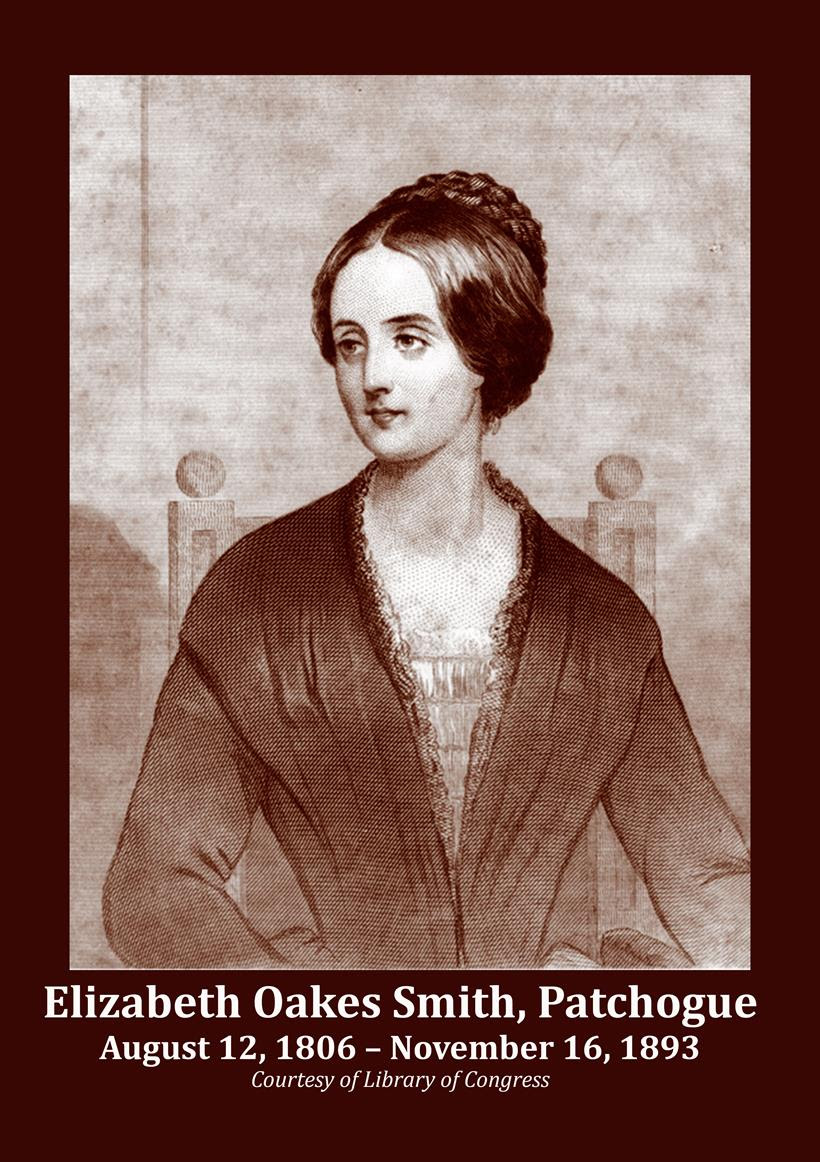
WOMEN’S HISTORY MONTH: Elizabeth Oakes Smith (1806-1893), Patchogue.
A champion of women’s rights, Elizabeth Oakes Smith was a gifted speaker as well as an author, poet, and playwright. She contributed poetry and prose to Godey’s Lady’s Book, Graham’s American Monthly, Southern Literary Messenger, and The Una, a mid-19th-century feminist journal owned, written, and edited entirely by women. Smith began her career as a temperance and antislavery advocate, and later became a spokesperson for the suffrage movement, lecturing with Lucretia Mott, president of the American Equal Rights Association. This group, which was founded in 1866, advocated the “right of suffrage, irrespective of race, color, or sex.” According to an article in the New York World, Smith and Mott traveled to Albany to petition the NY Legislature to reject the ratification of the 14th Amendment for its lack of gender-neutral language, arguing that the word male, appearing three times in the amendment, was a “gross outrage” to women citizens and taxpayers.
At the Women’s Rights Convention of 1852, Smith shared the speaker’s platform with Susan B. Anthony and Lucretia Mott. She delivered a powerful message for the suffrage movement, advocating for economic independence for women, for fair wages for their work, and for every woman to learn a trade. A nominee for president and vice-president on the Woman Suffrage tickets of the 1860s, Smith stirred the nation with her Woman and Her Needs, a pamphlet published as a series of articles in the New York Tribune. Women should be free to develop their talents to the fullest, she wrote, arguing that “women be accepted as citizens and emancipated from the restrictions that imposed false standards upon them.” She stressed the need for women’s economic independence, and considered the vote for women to be essential. Since women were taxed, they should have a say in the laws they were required to obey.
In 1859, Smith and her family moved to Patchogue, purchasing the Squire Woodhull property. Her husband was the well-known humorist Seba Smith, who wrote under the pen name Major Jack Downing. After the death of her husband in 1868, Smith lived for a time in Blue Point, where she wrote dime novels and her autobiography. She continued to lecture on women’s rights in New York in the 1870s. Elizabeth Oakes Smith is buried in the historic Roe Cemetery of Patchogue.
******************************************
Visit: www.suffolkcountyhistoricalsociety.org
To View 2014 Photo of the Week pages click here.
To View 2015 Photo of the Week pages click here.
To View 2016 Photo of the Week pages click here.
To View 2017 Photo of the Week pages click here.
To View 2018 Photo of the Week pages click here.
___________________________________________
PHOTO OF THE WEEK: February 23, 2019— FROM THE SCHS LIBRARY ARCHIVES
“How shall we know it is us without our past?”
– John SteinbeckShipwreck off Fire Island
by Wendy Polhemus-Annibell, Head Librarian
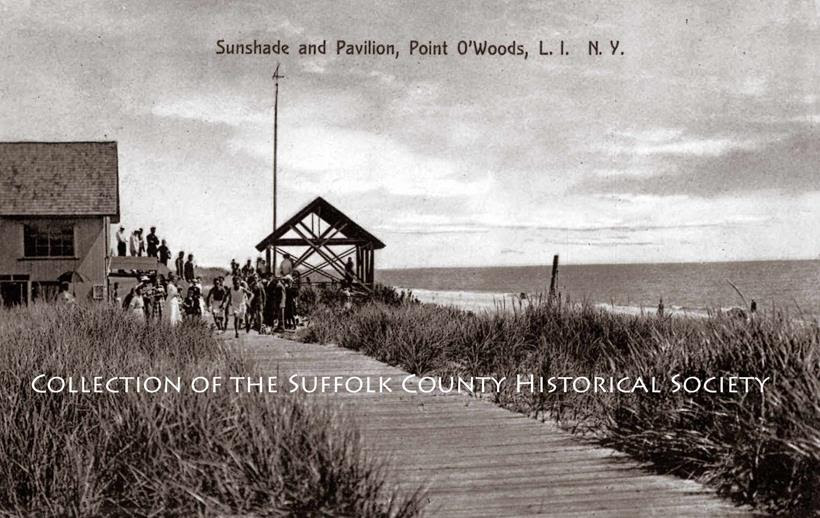
Fire Island’s Historic 1850 Shipwreck. (From the Collection of the Suffolk County Historical Society Library Archives. Image Copyright © Suffolk County Historical Society. All rights reserved.)
Among the many shipwrecks along the south shore of Long Island was the July 19, 1850 wreck of the bark Elizabeth, a few miles east of the Fire Island Lighthouse at what would become Point O’ Woods. The Elizabeth was one of the most publicized shipwrecks to precede the founding of the United States Life-Saving Service. Sailing from Italy, the vessel was carrying a cargo of marble, silk, oils, and soaps, as well as five passengers and a crew of fourteen. Ten people lost their lives in the wreck.
Margaret Fuller was among those who perished in the Elizabeth wreck, along with her husband and child. An author, teacher, editor, critic, transcendentalist, advocate of women’s rights, and feminist, Fuller’s book Woman in the Nineteenth Century (1845), a major work in American feminism, brought recognition to women’s intellectual contributions at a time when women were not permitted to receive a college education. Her literary peers included Henry David Thoreau, Ralph Waldo Emerson, and Oliver Wendell Holmes, among others. Fuller’s death was publicized by her fellow literary colleagues, which served to increase pressure to reform life-saving measures along our nation’s shores.
Learn more about the life and death of Margaret Fuller and the shipwreck of the Elizabeth off Fire Island at our upcoming Women’s History Month Book & Bottle event, Margaret Fuller: America’s First Feminist, presented by Frank Turano, on Thursday, March 7, 2019 – 6:00 pm. Call to reserve: 631-727-2881 x100.
————–
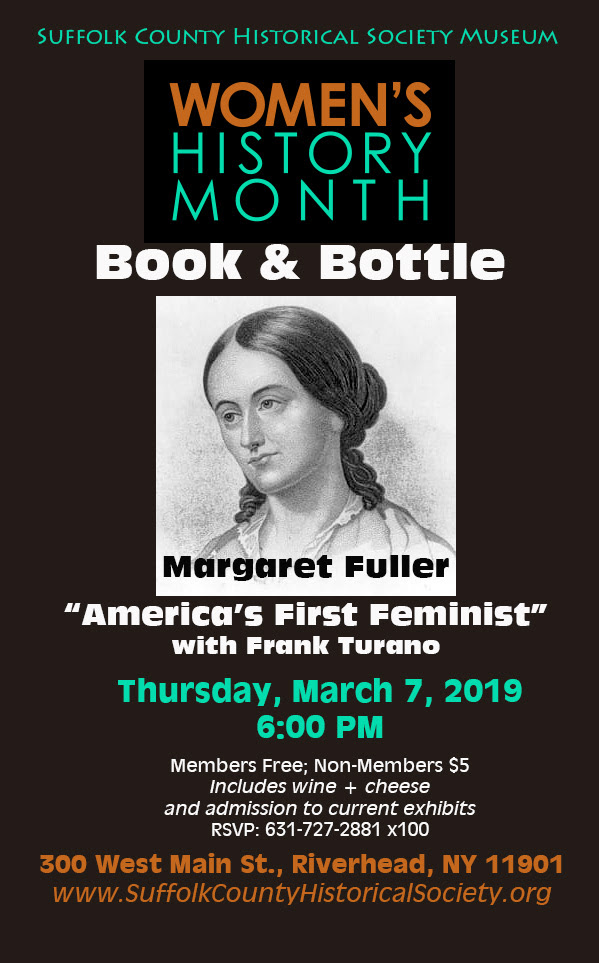
******************************************
Visit: www.suffolkcountyhistoricalsociety.org
To View 2014 Photo of the Week pages click here.
To View 2015 Photo of the Week pages click here.
To View 2016 Photo of the Week pages click here.
To View 2017 Photo of the Week pages click here.
To View 2018 Photo of the Week pages click here.
___________________________________________
PHOTO OF THE WEEK: February 16, 2019— FROM THE SCHS LIBRARY ARCHIVES
“How shall we know it is us without our past?”
– John SteinbeckThe Henry Perkins, Riverhead
by Wendy Polhemus-Annibell, Head Librarian

Henry Perkins Hotel Letterhead, c. 1930. (From the Collection of the Suffolk County Historical Society Library Archives. Image Copyright © Suffolk County Historical Society. All rights reserved.)
The Henry Perkins Hotel opened in Riverhead on August 11, 1929. Still located at the corner of West Main Street and Osborn Avenue in downtown Riverhead (where it now serves as an adult home), the Henry Perkins Hotel was considered one of the finest hotels of its size and type in the country. August H. Galow designed the building in keeping with the planned architecture of the soon to be neighboring Suffolk County Historical Society, which he also designed. The kitchen was designed by Walter J. Buzzini, who had also designed the large kitchen at the Biltmore Hotel in NYC. Much of the finer class of millwork used in the construction of the hotel was supplied by E. Bailey & Sons, a lumber and supply company located in Patchogue.
The new Henry Perkins Hotel was equipped with seventy-seven spacious bedrooms, a cheerful fine-dining room, 3,200 plates, 2,200 pieces of silver flatware, and assorted modern conveniences, such as stock market tickers so guests could keep an eye on the market. Boasting an inviting and home-like atmosphere and traditional hospitality, as well as safe, “fireproof” construction, the hotel was named after J. Henry Perkins, a Riverhead native who had served as Deputy Sheriff and Treasurer for the county.
******************************************
Visit: www.suffolkcountyhistoricalsociety.org
To View 2014 Photo of the Week pages click here.
To View 2015 Photo of the Week pages click here.
To View 2016 Photo of the Week pages click here.
To View 2017 Photo of the Week pages click here.
To View 2018 Photo of the Week pages click here.
___________________________________________
PHOTO OF THE WEEK: February 9, 2019— FROM THE SCHS LIBRARY ARCHIVES
“How shall we know it is us without our past?”
– John SteinbeckMANUMISSIONS
by Wendy Polhemus-Annibell, Head Librarian

Manumissions, by Jonathan Jagger of Southampton, of Pegg and Her Child Tamer, 1797. (From the Grathwohl Collection of the Suffolk County Historical Society Library Archives. Image Copyright © Suffolk County Historical Society. All rights reserved.
———————–
Slavery was officially abolished in New York State in 1827, less than two hundred years ago. In 1698, some 1,100 slaves called “bondsman” resided on Long Island; 10 percent of the population of Southampton was enslaved at this time. In 1749, some 3,400 slaves resided on Long Island; and in 1775, on the eve of the American Revolution, there were 5,000 slaves.
Manumissions (the freeing of slaves) increased during and after the Revolution. In 1788, a manumission law was enacted that provided for freeing slaves but protected those who were elderly or ill from being freed without adequate provisions for their care. New York declared that all children born of slaves after July 4, 1799, were free, though the owners could retain the male child’s service until age twenty-eight and the female’s until age twenty-five. However, the slaveowner could also elect to abandon his claim to the child’s service and pass the responsibility for supporting the child to the state.
The manumission document shown here is transcribed as follows: “Know all men by these presents that I, Jonathan Jagger of Southampton, County of Suffolk, and state of New York do promise to let a Mullato servant woman called Pegg that I purchased of Capt. James Reeve be free at the end of five years from the date hereof and her child Tamer, which is now one year and six months old, at the age of thirty years provided they can secure said Jagger or his heirs and assigns from the maintenance of them. The said Pegg and Tamer in witness whereof I have set my hand and seal this 9th of October 1797. — Jonathan Jagger, in the presence of John Youngs
A state law enacted in 1817 provided that by 1827 all slaves in New York would be considered free.
******************************************
Visit: www.suffolkcountyhistoricalsociety.org
To View 2014 Photo of the Week pages click here.
To View 2015 Photo of the Week pages click here.
To View 2016 Photo of the Week pages click here.
To View 2017 Photo of the Week pages click here.
To View 2018 Photo of the Week pages click here.
___________________________________________
PHOTO OF THE WEEK: February 2, 2019— FROM THE SCHS LIBRARY ARCHIVES
“How shall we know it is us without our past?”
– John SteinbeckSarah J. Smith Garnet, Educator & Suffragist
by Wendy Polhemus-Annibell, Head Librarian
~~~~~~~~~~~~~~~~~~~~~~~~~~~~~~~~~~~~~~~~~~
Celebrating Black History Month: SARAH J. SMITH GARNET (1831-1911).
Sarah J. Smith Garnet was an educator and an early suffragist who lived in Brooklyn and had Shinnecock and Montaukett ancestry. She was a pioneer as the first African American female school principal in the New York City school system, a post she held for thirty-seven years. She was also the older sister of Susan Smith McKinney Steward (1847-1918), the first African American woman in New York state to graduate with a medical doctorate (M.D.).
Garnet had two marriages. Her first husband, Samuel Tompkins, passed away in 1852, and her two children from that marriage also died prematurely. In 1879, at age 48, she married Henry Highland Garnet, a respected Presbyterian minister, a fighter for black voting rights, an opponent of slavery, and the first African American to address the U.S. Congress. Sarah was widowed again when her second husband died in 1882, two months into his post as United States Ambassador to Liberia.
In the late 1880s, Sarah Garnet organized the Equal Suffrage League, the first suffrage group formed in Brooklyn by an African American woman. The group advocated for voting rights for black women. After her retirement from the public school system, Garnet traveled to England to learn about the suffrage movement there. She worked on various national and local suffrage scenes, becoming the superintendent of the suffrage department of the National Association of Colored Women. As a member of the Equal Suffrage Club, Garnet supported the Niagara Movement, a predecessor to the National Association for the Advancement of Colored People (NAACP).
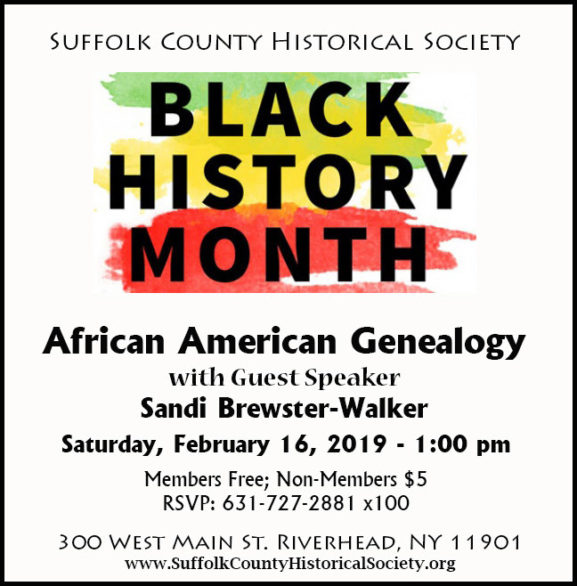
******************************************
Visit: www.suffolkcountyhistoricalsociety.org
To View 2014 Photo of the Week pages click here.
To View 2015 Photo of the Week pages click here.
To View 2016 Photo of the Week pages click here.
To View 2017 Photo of the Week pages click here.
To View 2018 Photo of the Week pages click here.
___________________________________________
PHOTO OF THE WEEK: January 26, 2019— FROM THE SCHS LIBRARY ARCHIVES
“How shall we know it is us without our past?”
– John SteinbeckA Treatise on Contrition
by Wendy Polhemus-Annibell, Head Librarian
~~~~~~~~~~~~~~~~~~~~~~~~~~~~~~~~~~~~~~~~~~
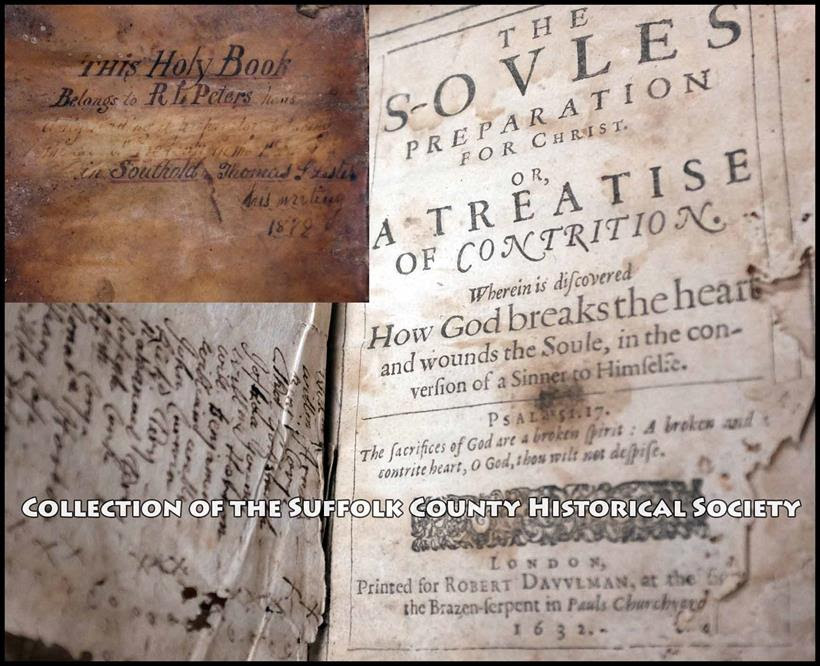
A Treatise of Contrition, by Thomas Hooker, 1632. (From the Collection of the Suffolk County Historical Society Library Archives. Copyright © Suffolk County Historical Society. All rights reserved.)
One of the oldest items in our library collection is this “The Soul’s Preparation for Christ: A Treatise of Contrition,” a holy book authored by the English minister Thomas Hooker and printed in London in 1632. Hooker (1586-1647) was a prominent Pilgrim colonial leader who founded the colony of Connecticut after dissenting with Pilgrim leaders in Massachusetts. He’s often referred to as the “Father of Connecticut” and was an important figure in the early development of colonial New England.
Based on the dozens of names written on the endpapers of this book (Horton, Benjamin, Terry, Wells, Reeve, etc.), we can surmise that it originates from the earliest days in Southold. Indeed, it is quite possible the book was brought over from England by the earliest settlers of Southold. Its cover, made of hide, was likely added to the 1632 manuscript sometime in the late seventeenth or early eighteenth century. The cover contains the following handwritten inscription:
“This Holy Book belongs to R. L. Peters. He is daily reading it prepartory to taking the seat of Deacon in the 1st Church in Southold. Thomas S. Lester his writing, 1879.”
Inside the book, on page 6, is written: “This Book belongs to R. L. Peters. Don’t steal it for God may say in that great day, where is my Holy Book you stole away from my friend Peters.”
We were unable to verify, with assistance from the First Presbyterian Church in Southold, that R. L. Peters ever served as a deacon in the church. Our best guess is that the book belonged to Richard Landon Peters (1812-1889), a farmer and lifelong resident of Southold.
Please note that due to the age and fragility of this 387-year-old book, it can be neither handled nor opened, and it is not kept in our regular library archives. Viewing the book without handling is possible, but by appointment only.
******************************************
Visit: www.suffolkcountyhistoricalsociety.org
To View 2014 Photo of the Week pages click here.
To View 2015 Photo of the Week pages click here.
To View 2016 Photo of the Week pages click here.
To View 2017 Photo of the Week pages click here.
To View 2018 Photo of the Week pages click here.
___________________________________________
PHOTO OF THE WEEK: January 19, 2019— FROM THE SCHS LIBRARY ARCHIVES
“How shall we know it is us without our past?”
– John SteinbeckQuogue vs. Quiogue
by Wendy Polhemus-Annibell, Head Librarian
~~~~~~~~~~~~~~~~~~~~~~~~~~~~~~~~~~~~~~~~~~
To view Harry T. Tuthill Fullerton Collection photo please visit Suffolk County Historical Society website:Quogue Pines, 1900. (Image from the Harry T. Tuthill Fullerton Collection of the Suffolk County Historical Society Library Archives. Copyright © Suffolk County Historical Society. All rights reserved.)
Not to be confused with Quogue, the hamlet of Quiogue (pronounced Quī-og) is located between the villages of Quogue and Westhampton Beach, and is bounded to the south by Quantuck Bay. Three hundred and sixty-plus years ago, Native Americans named and inhabited the area now called Quiogue, meaning “Little Quogue.” The first written use of the name Quiogue in the Southampton Town records occurred in 1707. This entry relates to the passing of land from Joseph Foster to his son, Daniel Foster.
The Village of Quogue was founded in 1649. The name Quogue means “a shaking marsh, cove, or estuary,” and was derived from the Native American word Quaquanantuck. The early settlers of Southampton realized the value of the broad natural salt marsh meadows near Quogue for grazing their cattle, oxen, swine, and sheep. Also, unlike some neighboring villages, Quogue offered direct access to the beach for fishing and whaling. Quogue was also described as a place where one could simultaneously “breathe the scent of ancient pines and the air of the ocean.”
Readings: Historical Profile of the Hamlet of Quiogue, by Ronald A. Michne Jr.; and Notes on Quogue, by Richard H. Post.
—————–
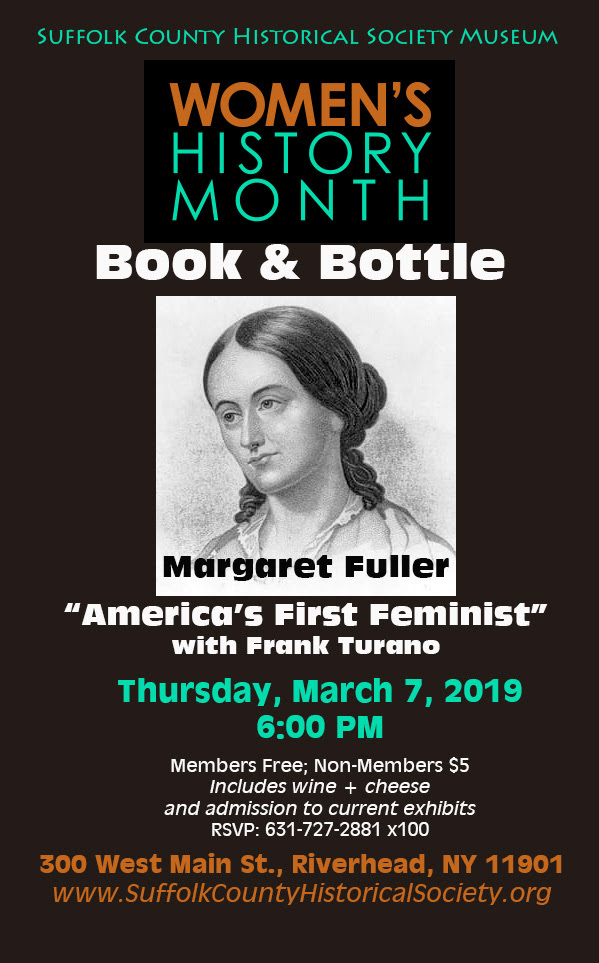
Call today to register: 631-727-2881 x100
Members Free; Non-Members $5. Incudes wine & cheese + admission to current exhibits!
******************************************
Visit: www.suffolkcountyhistoricalsociety.org
To View 2014 Photo of the Week pages click here.
To View 2015 Photo of the Week pages click here.
To View 2016 Photo of the Week pages click here.
To View 2017 Photo of the Week pages click here.
To View 2018 Photo of the Week pages click here.
___________________________________________
PHOTO OF THE WEEK: January 12, 2019— FROM THE SCHS LIBRARY ARCHIVES
“How shall we know it is us without our past?”
– John SteinbeckFlanders
by Wendy Polhemus-Annibell, Head Librarian
~~~~~~~~~~~~~~~~~~~~~~~~~~~~~~~~~~~~~~~~~~
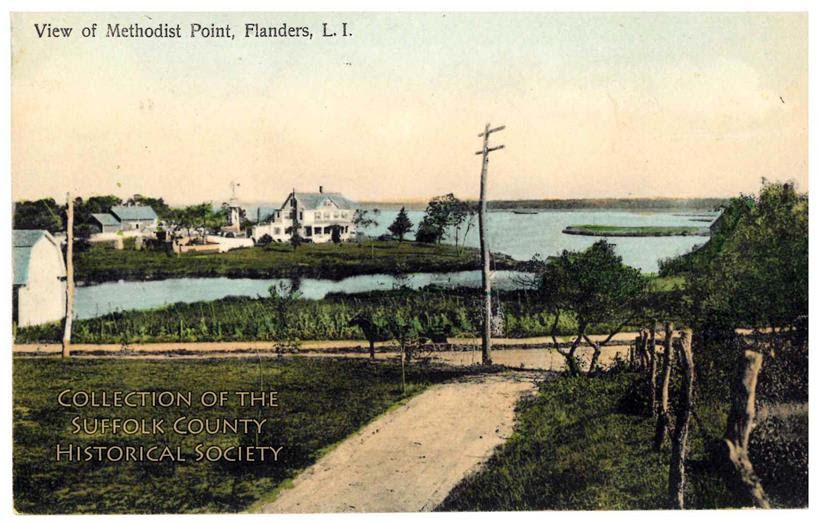
A View of Methodist Point in Flanders, c. 1902. (From the Collection of the Suffolk County Historical Society Library Archives. Image © copyright Suffolk County Historical Society. All rights reserved.)
About two miles from Riverhead is the hamlet bearing the name Flanders. How and when Flanders acquired its name remain a mystery, though it may be that the hamlet adopted the name based on its wetlands and other similarities with the Flanders region of present-day Belgium in Europe. The word “Flanders” is adopted from the Flemish “Vlaanderen,” which means “flooded land.”
It’s believed that the first settlement was made in Flanders about 1770, and the first English settlers included Josiah Goodale and Ellis Squires. Southampton Town records refer to Goodale’s house at “Aukabog” as early as 1761, and other references indicate that the structure was likely built prior to 1760. Josiah is credited with clearing much of the land in the hamlet area, and his descendants continue to reside there today. A Congregational church was built in Flanders about 1840, and a Methodist church was built about 1860.
Another early inhabitant of Flanders was James Fanning II, a Southold native and son of Captain James Fanning, who was a hero of the French Indian War and the first of the Fannings to settle on Long Island. The oldest known surviving house in the hamlet is that of James Benjamin. His homestead, built in circa 1782 and located on Flanders Road, is listed on the National Register of Historic Places.
Suggested Reading: History of Suffolk County (Munsell, 1882).
******************************************
Visit: www.suffolkcountyhistoricalsociety.org
To View 2014 Photo of the Week pages click here.
To View 2015 Photo of the Week pages click here.
To View 2016 Photo of the Week pages click here.
To View 2017 Photo of the Week pages click here.
To View 2018 Photo of the Week pages click here.
___________________________________________
PHOTO OF THE WEEK: January 5, 2019— FROM THE SCHS LIBRARY ARCHIVES
“How shall we know it is us without our past?”
– John SteinbeckJefferson Echo Building, c. 1920
by Wendy Polhemus-Annibell, Head Librarian
~~~~~~~~~~~~~~~~~~~~~~~~~~~~~~~~~~~~~~~~~~
Jefferson Echo Building, c. 1920. (From the Collection of the Suffolk County Historical Society Library Archives. Image © copyright Suffolk County Historical Society. All rights reserved.)
The Port Jefferson Echo was a local newspaper published weekly for nearly forty years, from 1892 until 1931. Established by Charles A. Squires, a native of Good Ground (Hampton Bays), the first issue was released on August 13, 1892, with the masthead noting the publication was “Devoted to the Welfare of Port Jefferson Village and Surrounding Communities.” It also names the location as “Echo, Long Island, N.Y.,” which a part of Port Jefferson village used to be called, and marks the annual subscription price at one dollar. Two years later, in 1894, the paper was endorsed as the official Republican paper by the Suffolk County Board of Supervisors.
The location of the building shown here was on Main Street near the railroad station. The Port Jefferson Echo occupied one-half of the building, and the Echo Post Office occupied the other half.
A. Jay Tefft purchased the Port Jefferson Echo in 1899, and remained its owner, editor, and publisher for many years. Mr. Tefft brought to the weekly his extensive experience as an editor of several NYC newspapers, helping to make the Echo “one of the best newspapers in the County” (according to historian Peter Ross). This week’s featured photograph from our library collection was among Mr. Teftt’s grandson’s personal effects.
~~~~~~~~~~~~~~~~~

UPCOMING EVENTS & EXHIBIT OPENINGS
Gish Gallery: “Oh, Sweet Spring!” opens March 7.
Weathervane Gallery: When Women Wore Whales opens April 13.
KIDS WEEK: April 24 – 27, 2019.
~~~~~~~~~~~~~~~~~~~~~~~
CURRENT EXHIBITS
The Long Island Express: Remembering the 1938 Hurricane, in our Gish Gallery.
The Silver Screens of Suffolk: Celebrating the History of Film from the 1900s to the 1960s, in our Grand Staas Gallery.
Spotlight Series: A Moment of Tranquili–TEA, in our History in the Hall Display Cases.
Spotlight Series: The Paintings. Highlights from the Permanent Collection, in our Weathervane Gallery.
~~~~~~~~~~~~~~~~~~~~~~
BOOK & BOTTLE LECTURE SERIES
Wine & Cheese or light refreshments included. Members Free; Non-Members $5. RSVP to (631) 727-2881 x100.
Saturday, Jan. 19, 2019. Jim Szakmary on A Veteran’s Reflections on the Vietnam War. 1:00 PM
Thursday, March 7, 2019. Frank Turano on Margaret Fuller: America’s First Feminist. 6:00 PM
******************************************
Visit: www.suffolkcountyhistoricalsociety.org
To View 2014 Photo of the Week pages click here.
To View 2015 Photo of the Week pages click here.
To View 2016 Photo of the Week pages click here.
To View 2017 Photo of the Week pages click here.
To View 2018 Photo of the Week pages click here.
_______________________________________________
==================================================================

